Fidler | Figures
Learn About Orchestration | Treatises | Figures
Fidler (1921), Handbook of Orchestration
This page contains all the figures — with new captions explaining each one — from Fidler’s 1921 Handbook of Orchestration.
Citation: Fidler, 1921, p. 14
Summary of Figure: A chart showing the ranges of the string instruments, including the lowest possible and highest recommended stopped and harmonic notes.
Instrumental Technique: strings ranges, harmonics
Fidler, 1921, p. 14 [Note: A chart showing the ranges of the string instruments, including the lowest possible and highest recommended stopped and harmonic notes.]
Citation: Fidler, 1921, p. 15
Summary of Figure: A chart showing the ranges of the wind instruments, with each instrument written according to its transposition and the corresponding sounding pitches on the top staff. Note values indicate the quality of tone on each instrument, where whole notes represent "the most perfect notes," sixteenth notes represent "the most imperfect," and note values in between represent the different gradations of tone quality.
Exemplification of: winds ranges, tone quality
Fidler, 1921, p. 15 [Note: A chart showing the ranges of the wind instruments, with each instrument written according to its transposition and the corresponding sounding pitches on the top staff. Note values indicate the quality of tone on each instrument, where whole notes represent "the most perfect notes," sixteenth notes represent "the most imperfect," and note values in between represent the different gradations of tone quality.]
Citation: Fidler, 1921, p. 16
Summary of Figure: A chart showing the ranges of the brass instruments, with each instrument written according to its transposition and the corresponding sounding pitches on the top staff. Note values indicate the quality of tone on each instrument, where whole notes represent "the most perfect notes," sixteenth notes represent "the most imperfect," and note values in between represent the different gradations of tone quality.
Exemplification of: brass ranges, tone quality
Fidler, 1921, p. 16 [Note: A chart showing the ranges of the brass instruments, with each instrument written according to its transposition and the corresponding sounding pitches on the top staff. Note values indicate the quality of tone on each instrument, where whole notes represent "the most perfect notes," sixteenth notes represent "the most imperfect," and note values in between represent the different gradations of tone quality.]
Citation: Fidler, 1921, p. 17
Summary of Figure: A chart showing the ranges of several percussion instruments, with each instrument written according to its transposition and the corresponding sounding pitches on the top staff. The timpani staff shows the ranges of the four common sizes of drum. Note values indicate the quality of tone on each instrument, where whole notes represent "the most perfect notes," sixteenth notes represent "the most imperfect," and note values in between represent the different gradations of tone quality.
Exemplification of: percussion ranges, tone quality
Fidler, 1921, p. 16 [Note: A chart showing the ranges of several percussion instruments, with each instrument written according to its transposition and the corresponding sounding pitches on the top staff. The timpani staff shows the ranges of the four common sizes of drum. Note values indicate the quality of tone on each instrument, where whole notes represent "the most perfect notes," sixteenth notes represent "the most imperfect," and note values in between represent the different gradations of tone quality.]
PART I - The Score
PART 1 - 1.
Chapter: PART 1 - 1. The String Orchestra
Citation: Fidler, 1921, p. 17
Summary of Figure: Several discontinuous examples from the 2nd movement of Beethoven's Symphony No. 3 ("Eroica") demonstrating string writing in general. Editor: Fidler references the string parts of the whole movement as an example, without specifying the excerpts chosen here.
Exemplification of: strings general writing style
Composer and Work: Beethoven, Ludwig van. Symphony No.3, op.55, E-flat major (Eroica) <1803> II. Marcia funebre: Adagio assai
Chapter: PART 1 - 1. The String Orchestra
Citation: Fidler, 1921, p. 18
Summary of Figure: An example from the 2nd movement of Beethoven's Symphony No. 3 ("Eroica") demonstrating several conventions of full score layout. Each instrumental line has its own clef, key signature, and expression markings, but tempo indications that affect all instrument are only placed at the top of the score.
Exemplification of: full score layout: clefs, key signatures, tempo indications
Composer and Work: Beethoven, Ludwig van. Symphony No.3, op.55, E-flat major (Eroica) <1803> II. Marcia funebre: Adagio assai
Fidler, 1921, p. 18 [Note: An example from the 2nd movement of Beethoven's Symphony No. 3 ("Eroica") demonstrating several conventions of full score layout. Each instrumental line has its own clef, key signature, and expression markings, but tempo indications that affect all instrument are only placed at the top of the score.]
Chapter: PART 1 - 1. The String Orchestra
Citation: Fidler, 1921, p. 18
Summary of Figure: An example from the 2nd movement of Beethoven's Symphony No. 3 ("Eroica") demonstrating the possibility of varying orchestral textures by not having all instruments play continuously. This example features the contrast between passages for the full string section and selected strings with both bassoons.
Exemplification of: textural variety, instrumentation contrasts
Composer and Work: Beethoven, Ludwig van. Symphony No.3, op.55, E-flat major (Eroica) <1803> II. Marcia funebre: Adagio assai
Fidler, 1921, p. 18 [Note: An example from the 2nd movement of Beethoven's Symphony No. 3 ("Eroica") demonstrating the possibility of varying orchestral textures by not having all instruments play continuously. This example features the contrast between passages for the full string section and selected strings with both bassoons.]
Chapter: PART 1 - 1. The String Orchestra
Citation: Fidler, 1921, p. 18
Summary of Figure: An example from the 2nd movement of Beethoven's Symphony No. 3 ("Eroica") demonstrating the possibility of varying orchestral textures by not having all instruments play continuously. This example features the sudden contrast between a passage for nearly the complete tutti and a quiet passage for selected strings.
Exemplification of: textural variety, instrumentation contrasts
Composer and Work: Beethoven, Ludwig van. Symphony No.3, op.55, E-flat major (Eroica) <1803> II. Marcia funebre: Adagio assai

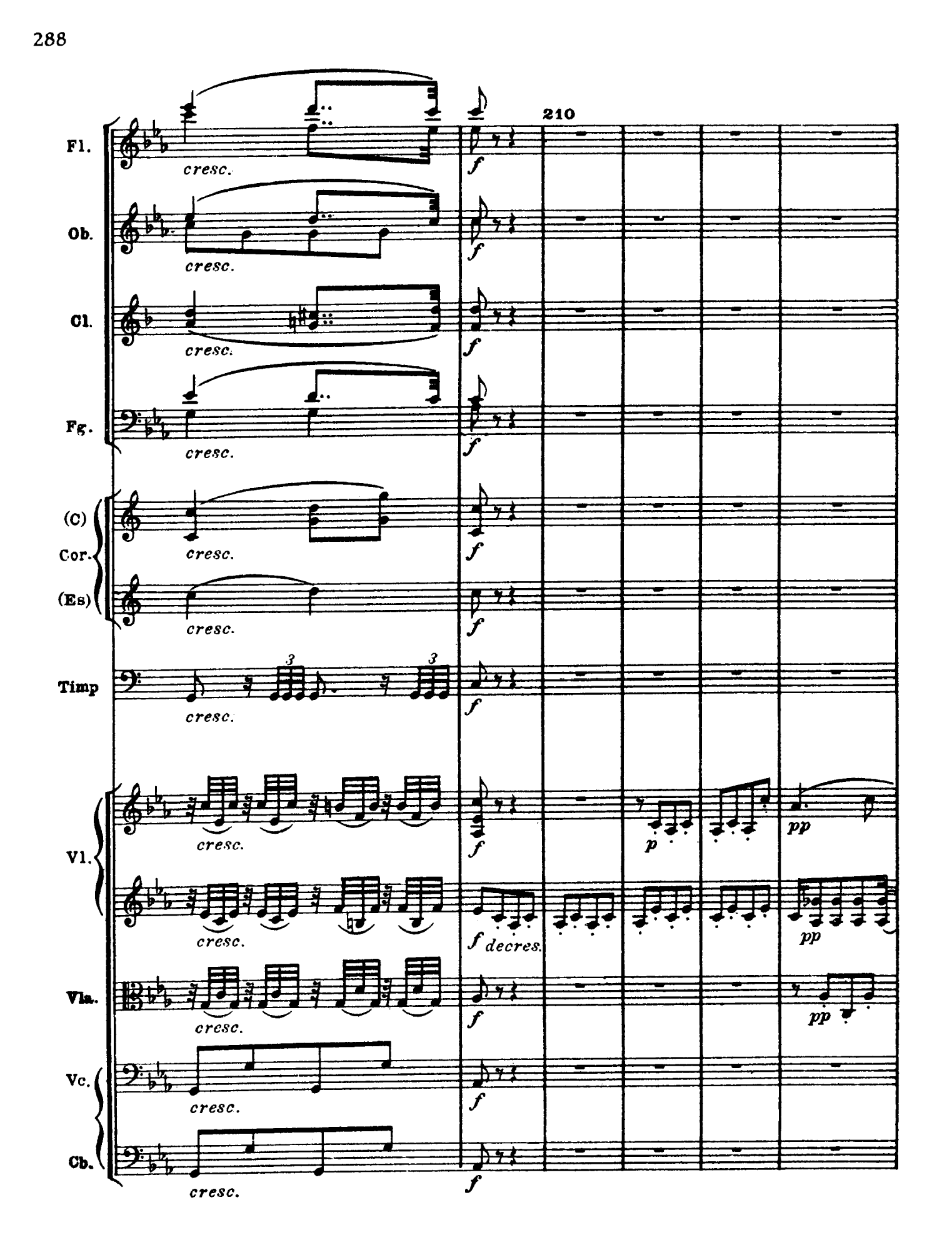
Chapter: PART 1 - 1. The String Orchestra
Citation: Fidler, 1921, p. 18
Summary of Figure: An example from the 2nd movement of Beethoven's Symphony No. 3 ("Eroica") demonstrating the possibility of varying orchestral textures by not having all instruments play continuously. This example features the contrast between a passage for selected winds and strings, and a passage for only violins with pizzicato cellos and basses.
Exemplification of: textural variety, instrumentation contrasts
Composer and Work: Beethoven, Ludwig van. Symphony No.3, op.55, E-flat major (Eroica) <1803> II. Marcia funebre: Adagio assai
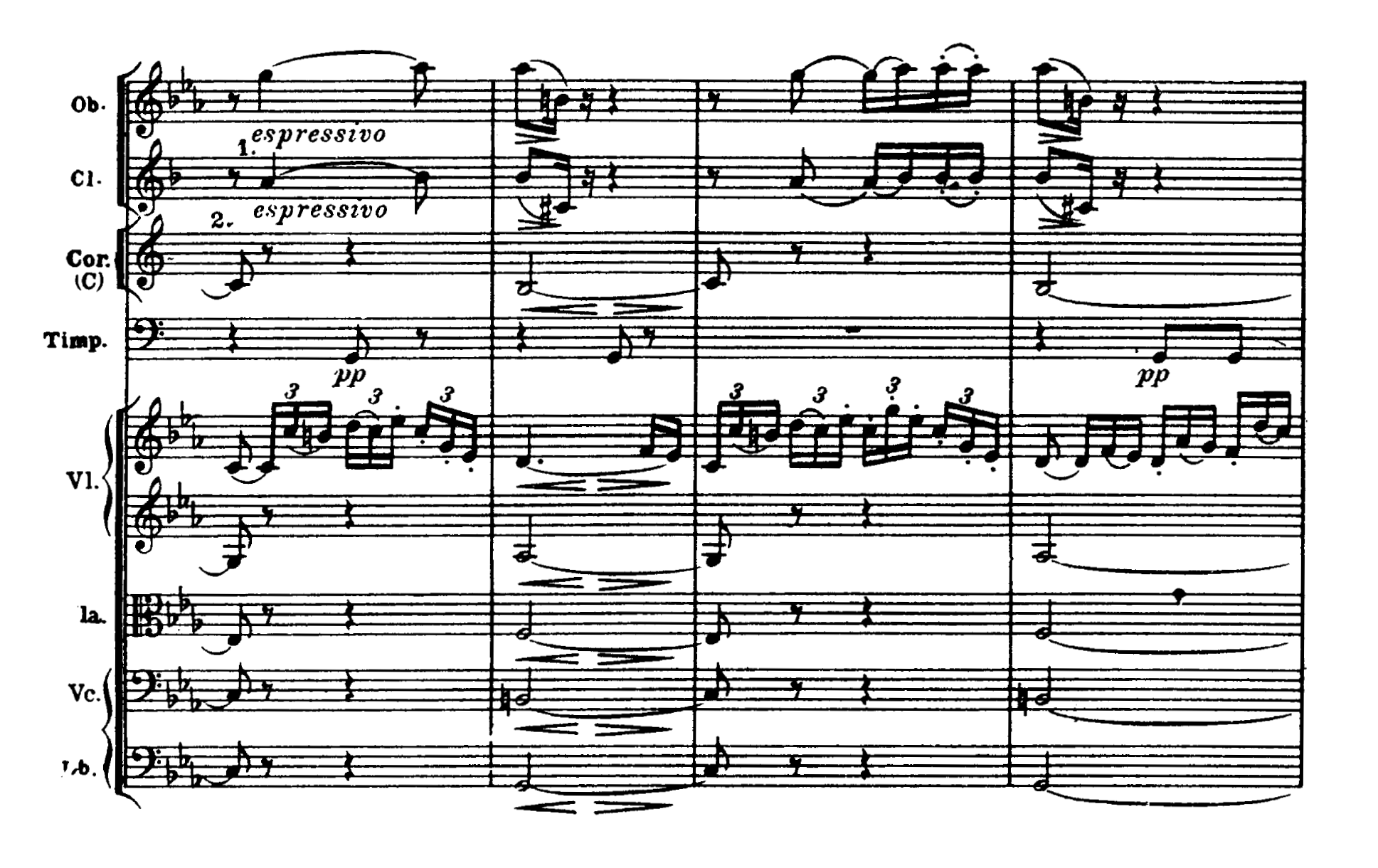
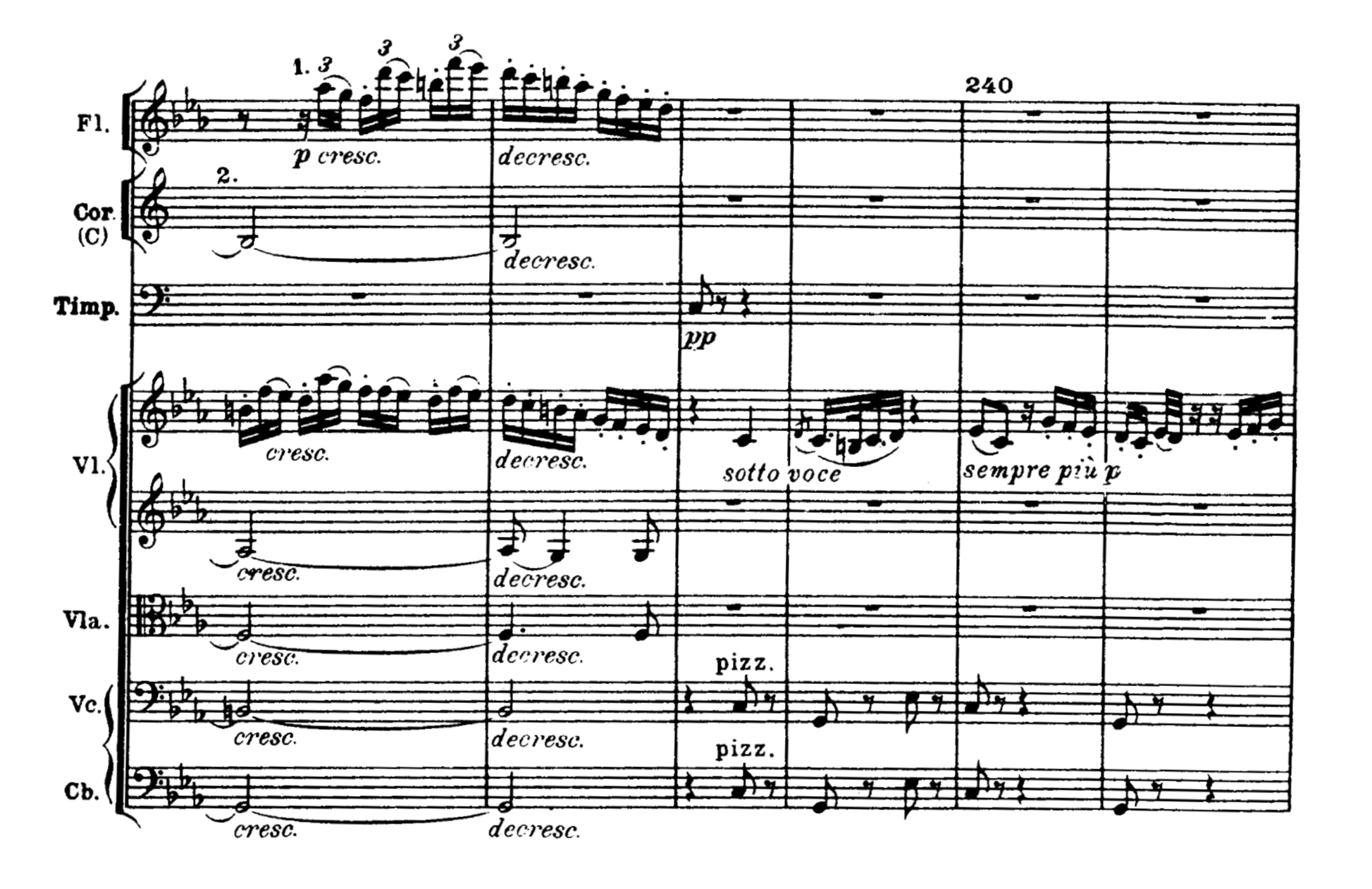
Chapter: PART 1 - 1. The String Orchestra
Citation: Fidler, 1921, p. 18
Summary of Figure: An example from the 2nd movement of Beethoven's Symphony No. 3 ("Eroica") demonstrating the possibility of writing for instruments and sections in different ranges and relative positions. In this example, the first violins begin below the second violins, then move above to play a melody which in turn is below a series of sustained notes in the oboe and clarinet.
Exemplification of: relative position of different instruments, voicing, violin range
Composer and Work: Beethoven, Ludwig van. Symphony No.3, op.55, E-flat major (Eroica) <1803> II. Marcia funebre: Adagio assai
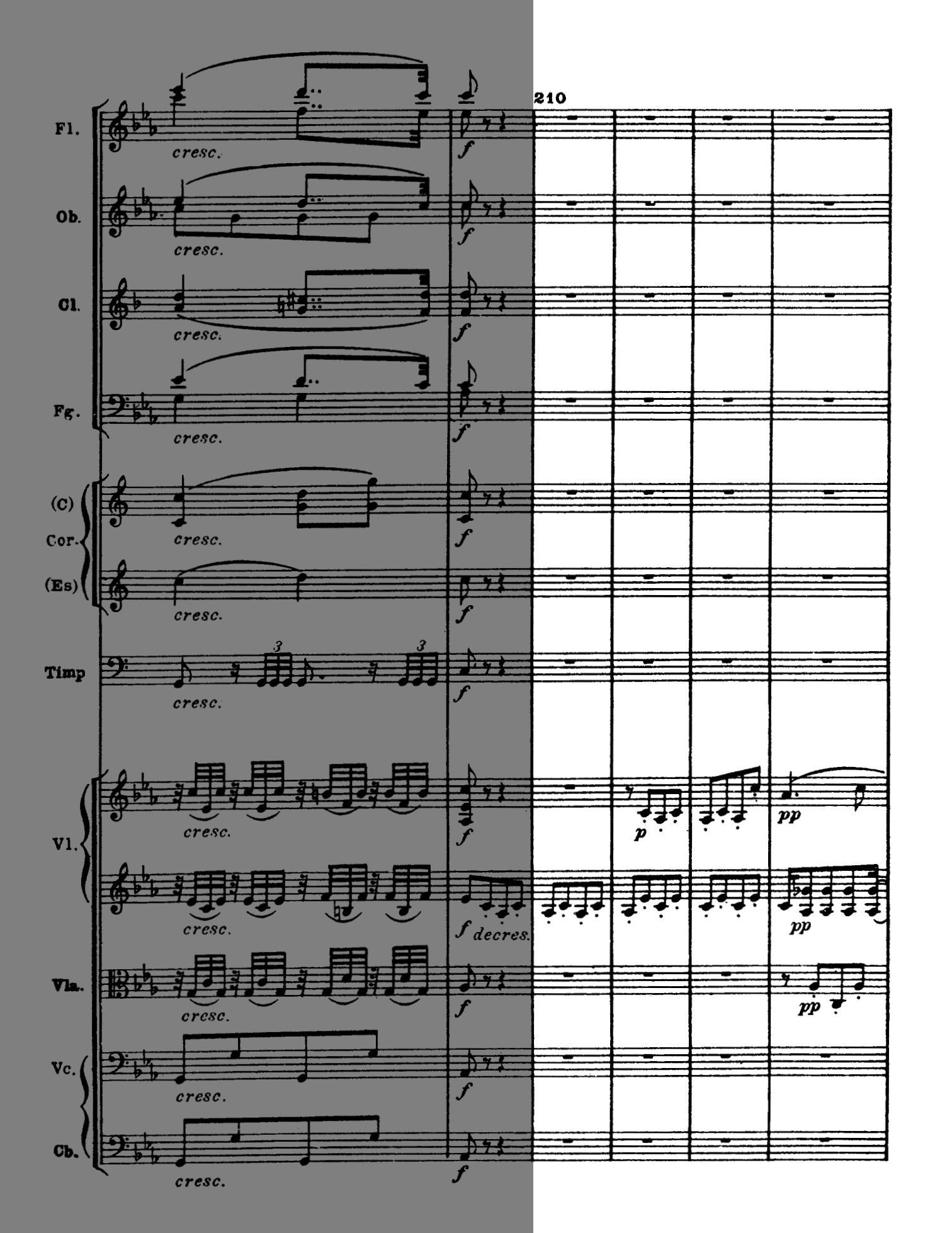
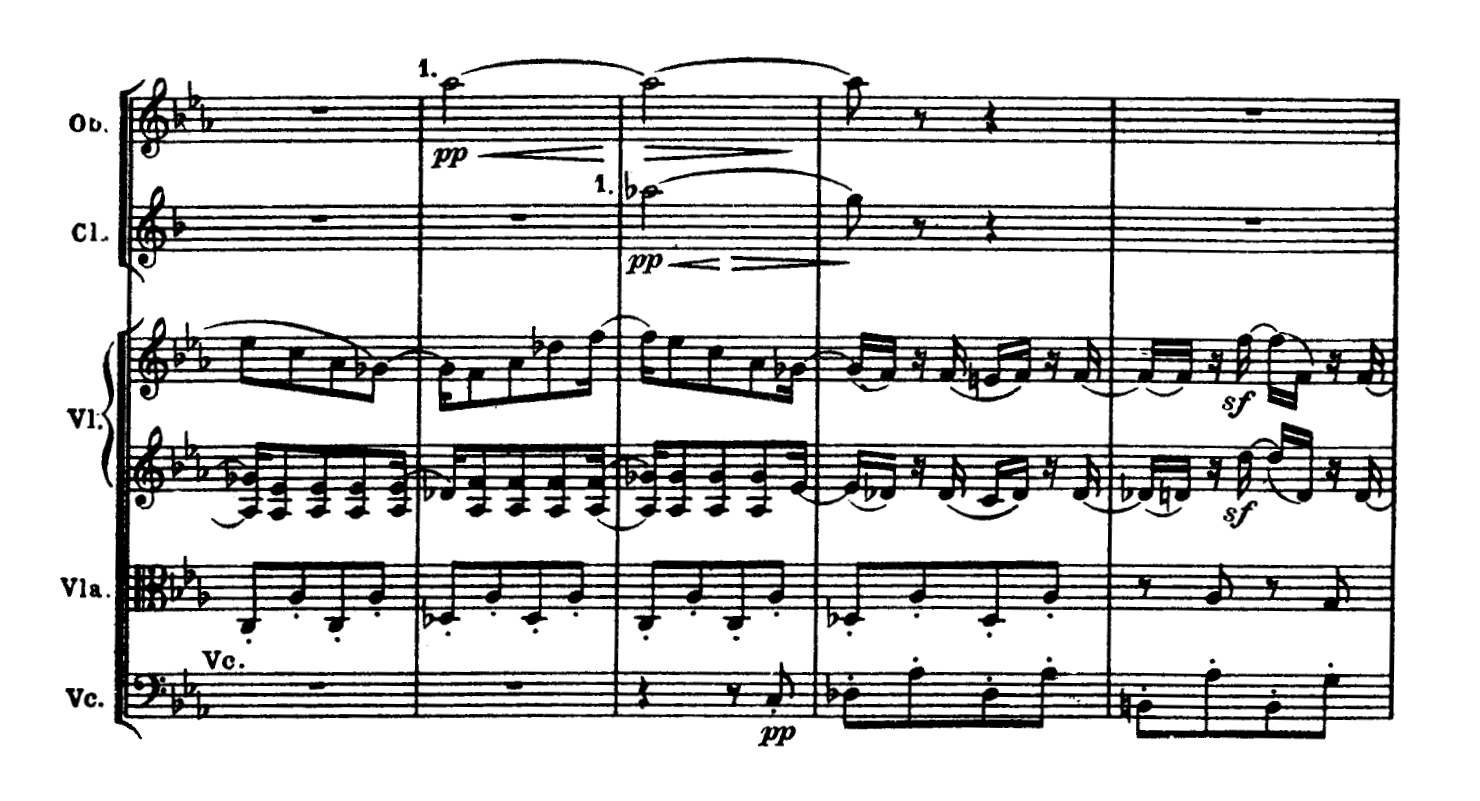
Chapter: PART 1 - 1. The String Orchestra
Citation: Fidler, 1921, p. 18
Summary of Figure: An example from the 2nd movement of Beethoven's Symphony No. 3 ("Eroica") demonstrating a rich texture with many examples of doubling (beginning at 5th bar of excerpt). The flutes and bassoons double a line two octaves apart, both pairs of oboes and clarinets double a line in unison, and the second violins, violas, and cellos double a lines in unison and tenths.
Exemplification of: clarinets-oboes unison doubling, flutes-bassoons two-octave doubling, violins-violas-cellos unison and tenth doubling
Composer and Work: Beethoven, Ludwig van. Symphony No.3, op.55, E-flat major (Eroica) <1803> II. Marcia funebre: Adagio assai


Chapter: PART 1 - 1. The String Orchestra
Citation: Fidler, 1921, p. 18
Summary of Figure: An example from the 2nd movement of Beethoven's Symphony No. 3 ("Eroica") demonstrating a passage for strings and brass with several examples of doubling. The octaves held by the horns are doubled at the unison by trumpets, and the string parts have octave doubling in the repeated notes for violins and violas, and the lines for cellos and basses (notated on the same staff).
Exemplification of: horns-trumpets unison/octave doubling, strings octave doubling
Composer and Work: Beethoven, Ludwig van. Symphony No.3, op.55, E-flat major (Eroica) <1803> II. Marcia funebre: Adagio assai
Fidler, 1921, p. 18 [Note: An example from the 2nd movement of Beethoven's Symphony No. 3 ("Eroica") demonstrating a passage for strings and brass with several examples of doubling. The octaves held by the horns are doubled at the unison by trumpets, and the string parts have octave doubling in the repeated notes for violins and violas, and the lines for cellos and basses (notated on the same staff).
Chapter: PART 1 - 1. The String Orchestra
Citation: Fidler, 1921, p. 19
Summary of Figure: Several discontinuous examples from the Scherzo of Beethoven's Symphony No. 3 ("Eroica") demonstrating string writing in general. Editor: Fidler references the string parts of the whole movement as an example, without specifying the excerpts chosen here.
Exemplification of: strings general writing style
Composer and Work: Beethoven, Ludwig van. Symphony No.3, op.55, E-flat major (Eroica) <1803> III. Scherzo: Allegro vivace
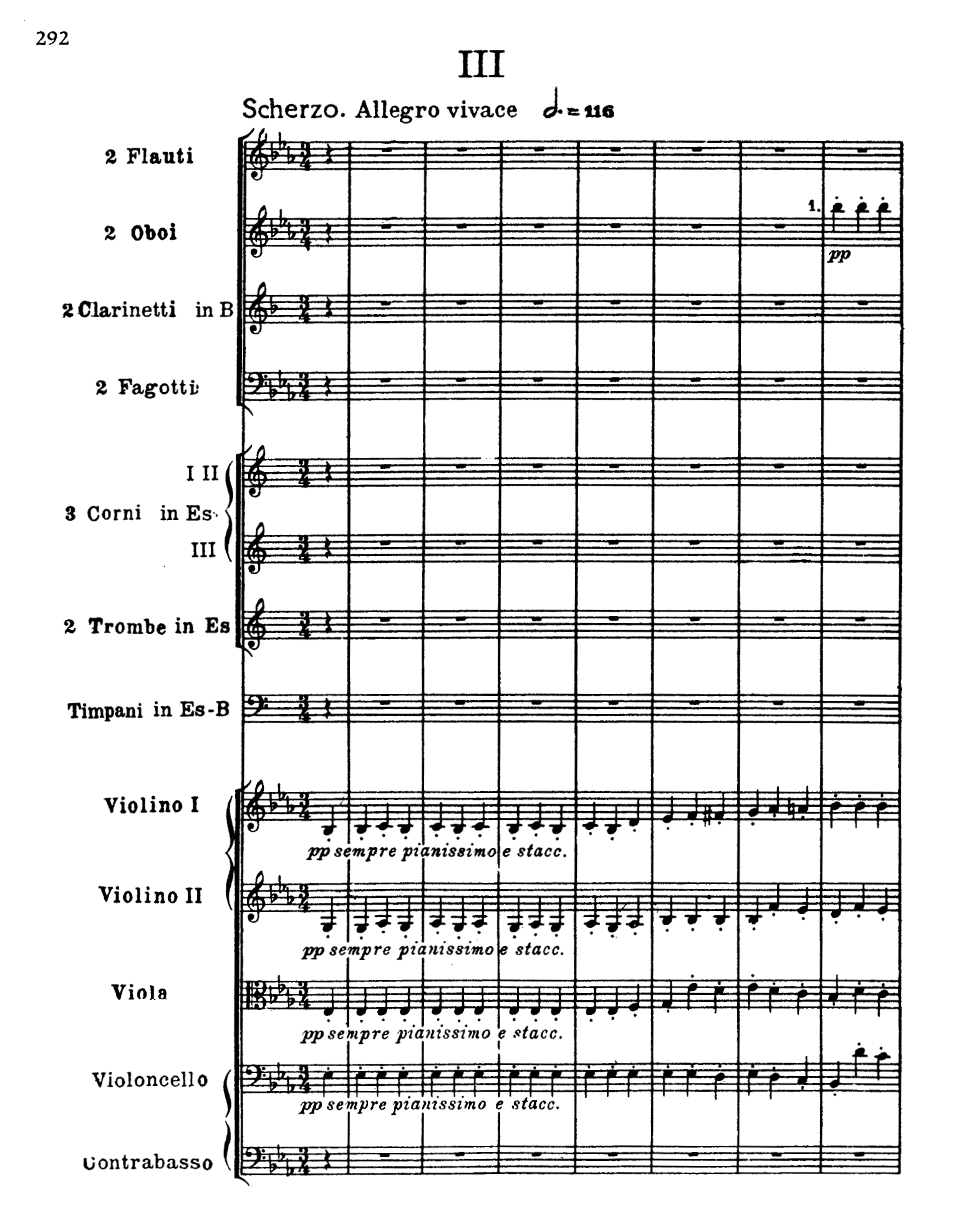




Chapter: PART 1 - 1. The String Orchestra
Citation: Fidler, 1921, p. 20
Summary of Figure: An example from the last movement of Beethoven's Symphony No. 3 ("Eroica") demonstrating string writing in general. Editor: Fidler references the string parts of the whole movement as an example, without specifying the excerpt chosen here.
Exemplification of: strings general writing style, strings without cellos and double bass
Composer and Work: Beethoven, Ludwig van. Symphony No.3, op.55, E-flat major (Eroica) <1803> IV. Finale: Allegro molto
Chapter: PART 1 - 1. The String Orchestra
Citation: Fidler, 1921, p. 20
Summary of Figure: An example from the "Overture miniature" of Tchaikovsky's "Nutcracker" demonstrating string writing in general. This excerpt, like the entire movement, features the use of a string section without cellos or basses. Editor: Fidler references the string parts of the whole movement as an example, without specifying the excerpt chosen here.
Exemplification of: orchestral version of pianistic arpeggio accompaniment
Composer and Work: Tchaikovsky, Piotr Ilyich. Nutcracker (Shchelkunchik; Casse-noisette): Suite No.1, op.71A, TH 35 <1891–1892> I. Overture miniature



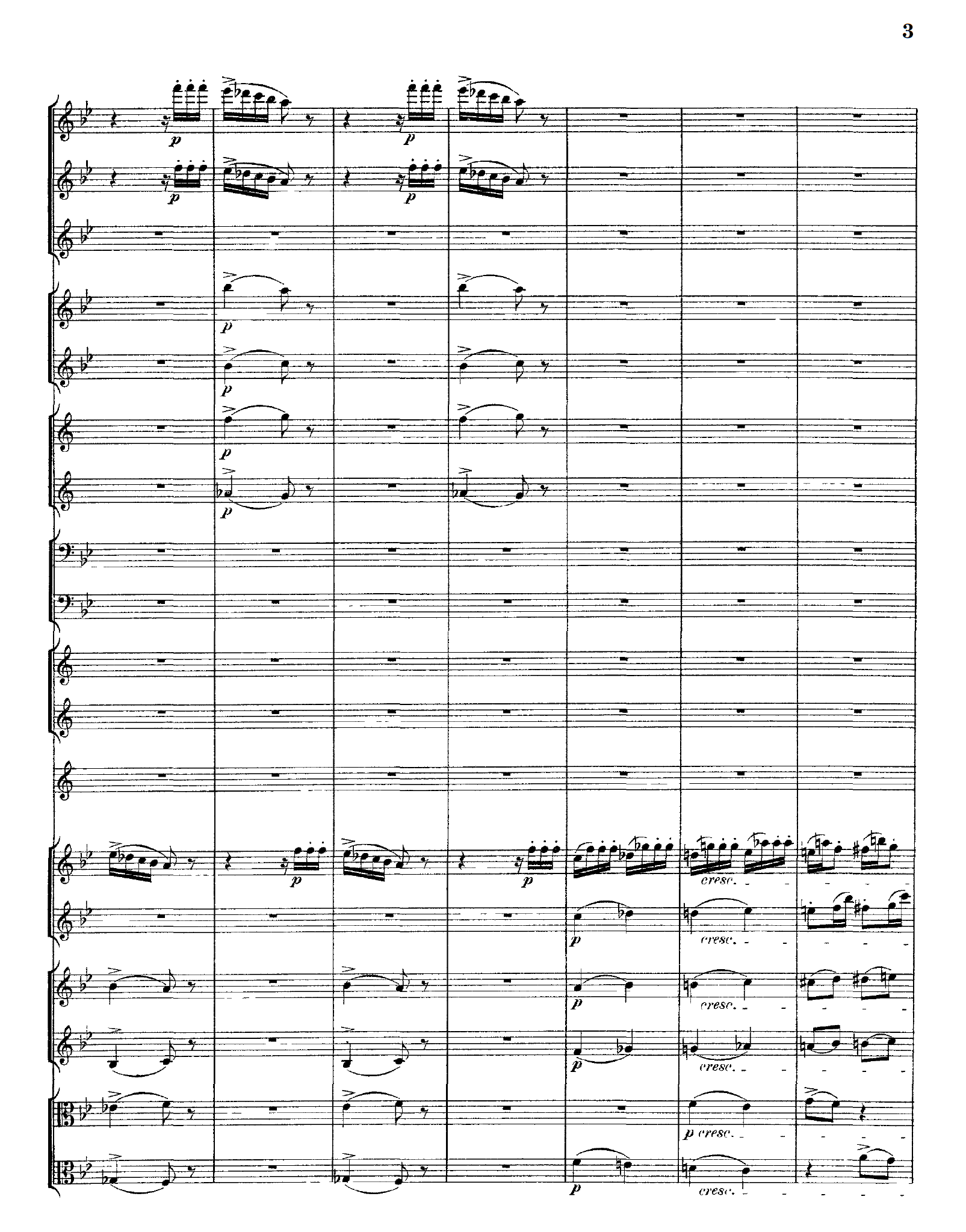

Chapter: PART 1 - 1. The String Orchestra
Citation: Fidler, 1921, p. 22
Summary of Figure: An example from Beethoven's Piano Sonata No. 9 showing a common arpeggiated accompanimantal figure that is idiomatic to the piano. Fidler suggests it is best translated to strings by distributing the notes of the chord to different sections and repeating them with sixteenth notes.zd
Exemplification of: piano arpeggiated accompaniment
Composer and Work: Beethoven, Ludwig van. Piano Sonata No.9, op.14/1, in E major. 1. Allegro
Chapter: PART 1 - 1. The String Orchestra
Citation: Fidler, 1921, p. 22
Summary of Figure: An example from the 2nd movement of Beethoven's Symphony No. 3 ("Eroica") demonstrating the use of repeated notes or tremolo in the strings as a common accompanimental feature analagous to arpeggiated chords for the piano. This example shows the technique in a forte passage with double stops or divisi in most string sections.
Exemplification of: orchestral version of pianistic arpeggio accompaniment, strings repeated notes, double stops
Composer and Work: Beethoven, Ludwig van. Symphony No.3, op.55, E-flat major (Eroica) <1803> II. Marcia funebre: Adagio assai
Fidler, 1921, p. 22 [Note: An example from the 2nd movement of Beethoven's Symphony No. 3 ("Eroica") demonstrating the use of repeated notes or tremolo in the strings as a common accompanimental feature analagous to arpeggiated chords for the piano. This example shows the technique in a forte passage with double stops or divisi in most string sections.]
Chapter: PART 1 - 1. The String Orchestra
Citation: Fidler, 1921, p. 22
Summary of Figure: An example from the 2nd movement of Beethoven's Symphony No. 3 ("Eroica") demonstrating the use of repeated notes or tremolo in the strings as a common accompanimental feature analagous to arpeggiated chords for the piano. This example shows the technique in a quiet accompanimental passage for violins and violas.
Exemplification of: orchestral version of pianistic arpeggio accompaniment, strings repeated notes
Composer and Work: Beethoven, Ludwig van. Symphony No.3, op.55, E-flat major (Eroica) <1803> II. Marcia funebre: Adagio assai

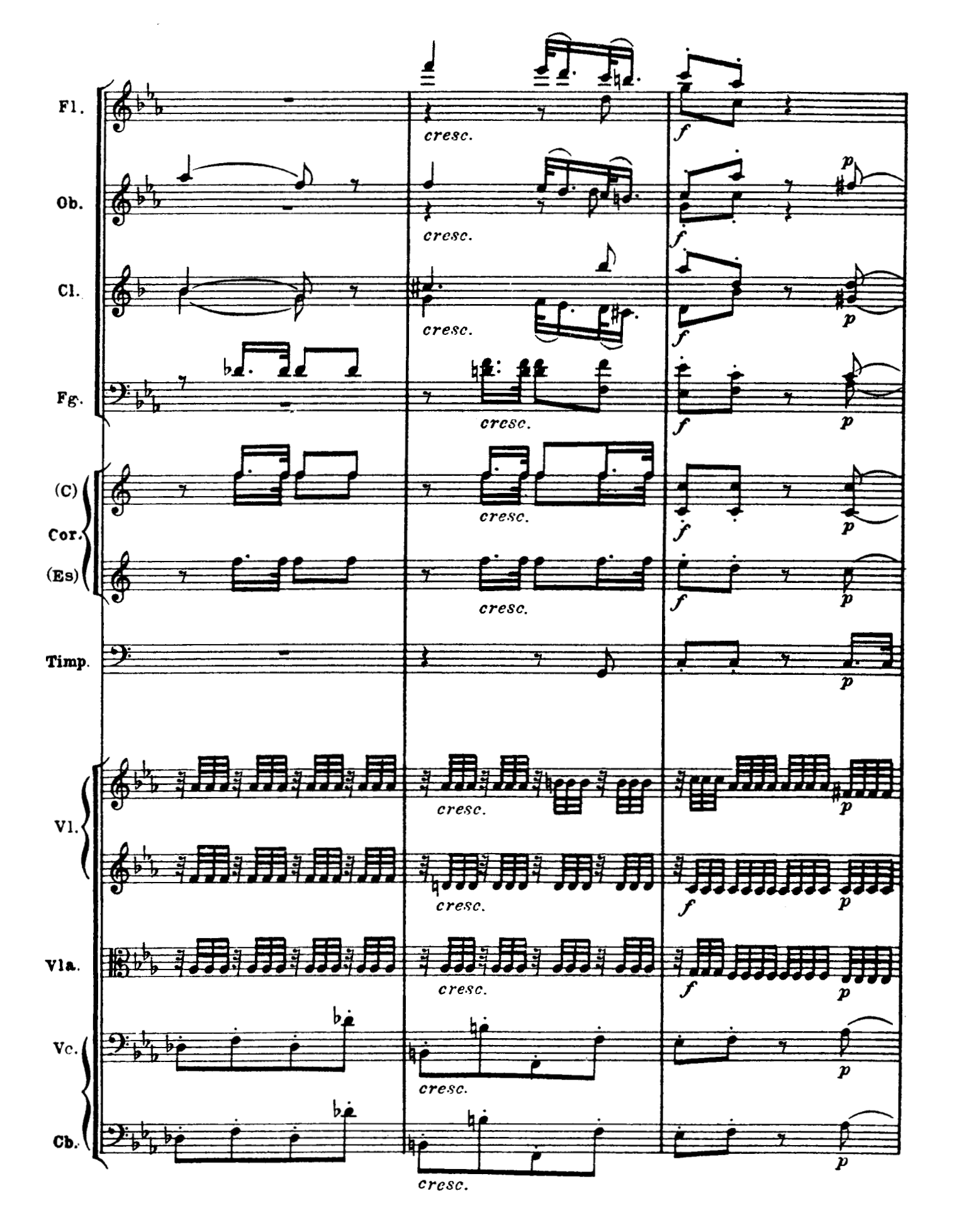
Chapter: PART 1 - 1. The String Orchestra
Citation: Fidler, 1921, p. 22
Summary of Figure: An example from the Presto in the last movement of Beethoven's Symphony No. 3 ("Eroica") demonstrating the use of repeated notes or tremolo in the strings. This example shows the technique in an energetic tutti passage, both as an accompanimental figure when staying on a single note, and adding activity when doubling the notes of scales and arpeggios.
Exemplification of: orchestral version of pianistic arpeggio accompaniment, strings repeated notes
Composer and Work: Beethoven, Ludwig van. Symphony No.3, op.55, E-flat major (Eroica) <1803> IV. Finale: Allegro molto
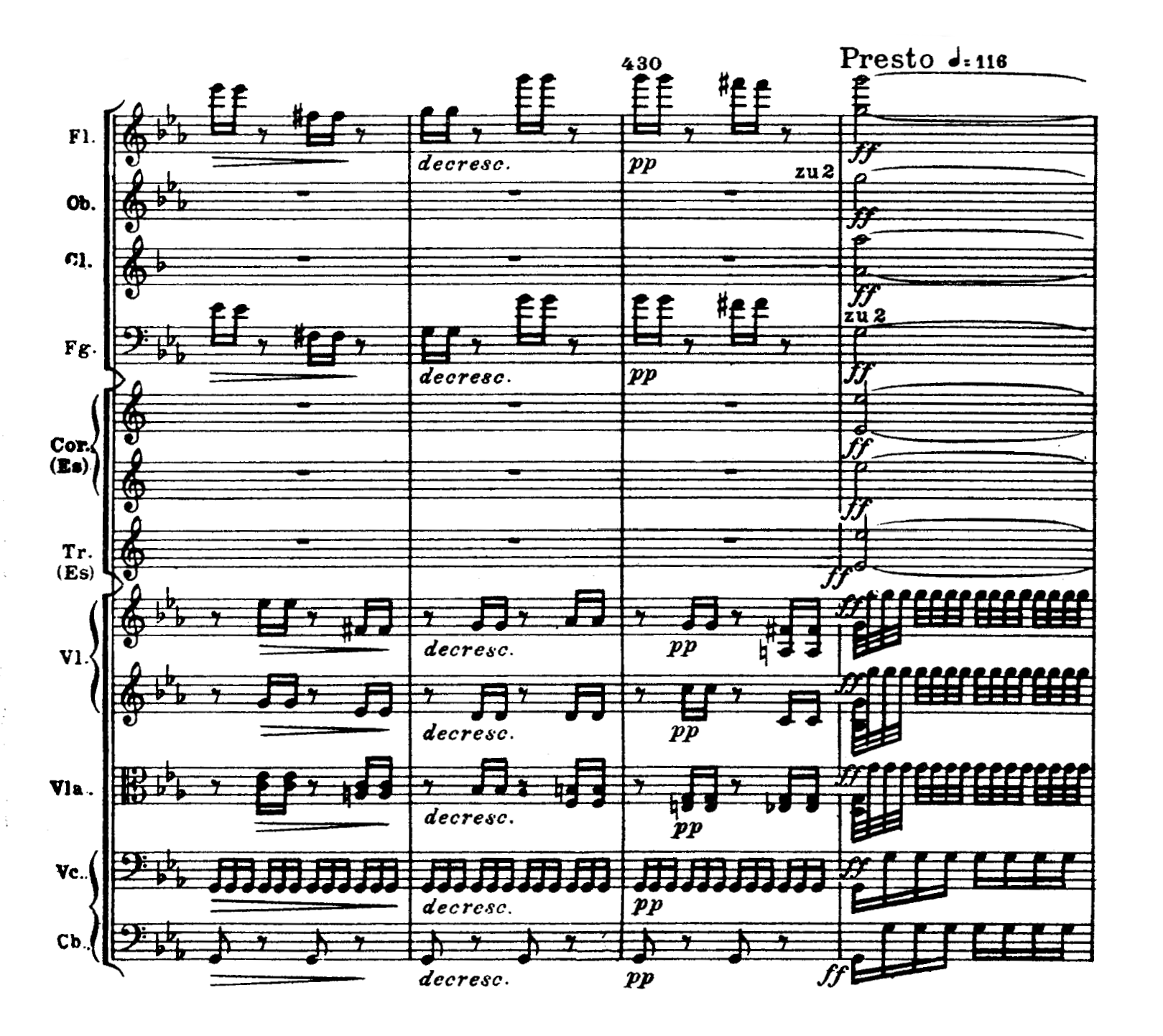


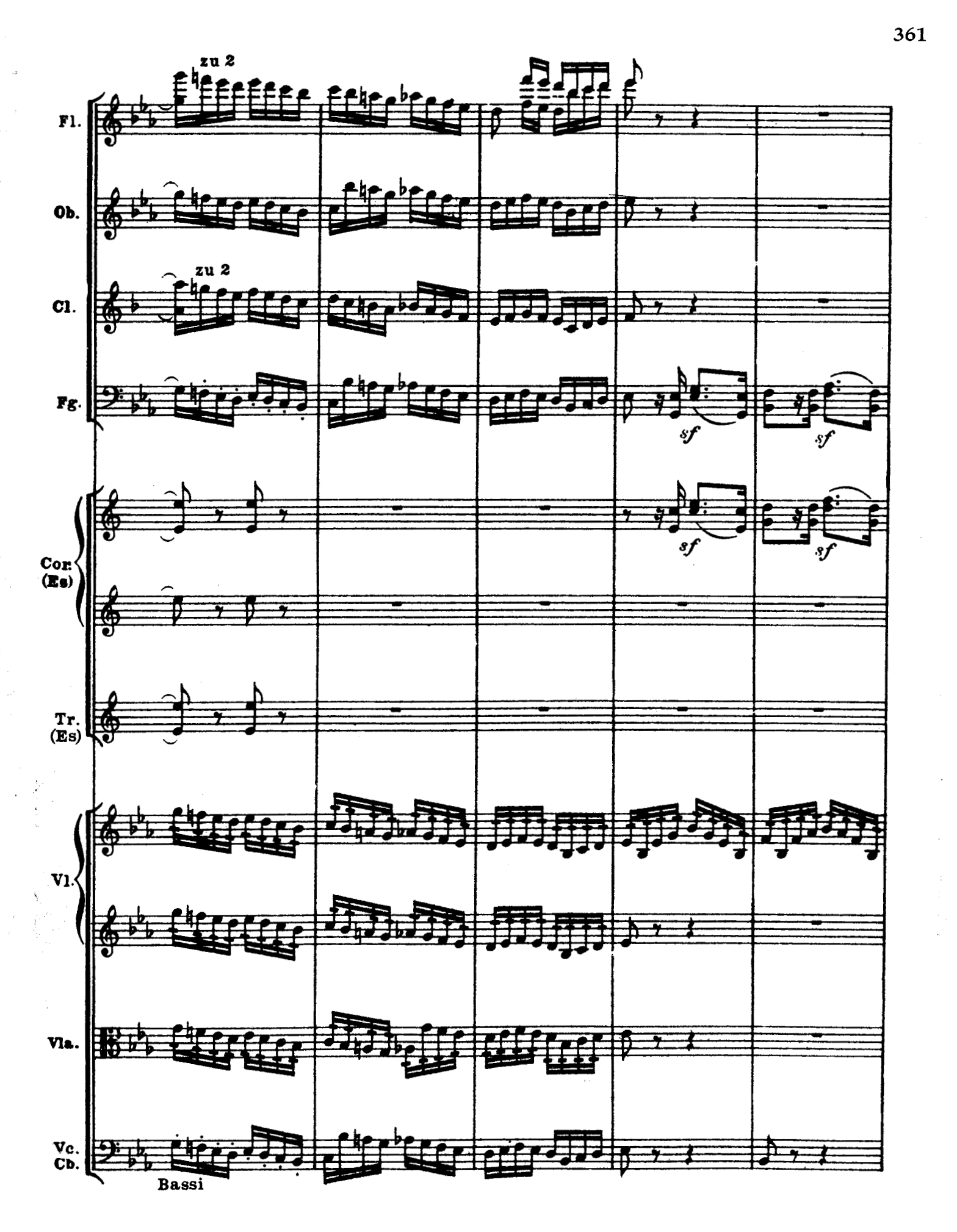
Chapter: PART 1 - 1. The String Orchestra
Citation: Fidler, 1921, p. 22
Summary of Figure: An example from the Scherzo of Mendelssohn's "Midsummer Night's Dream" demonstrating a chromatic scale passed from the cellos through each string section to the first violin. This excerpt exemplifies Fidler's recommendation to have such continuing figures overlap or "dovetail" for at least one note between sections.
Exemplification of: continuation, overlap/dovetailing between string parts, strings registers, chromatic scales
Composer and Work: Mendelssohn, Felix. A Midsummer Night's Dream, op.21 & 61 (Ein Sommernachtstraum) <1827–1843> 1. Scherzo (after Act I)
Fidler, 1921, p. 22 [Note: An example from the Scherzo of Mendelssohn's "Midsummer Night's Dream" demonstrating a chromatic scale passed from the cellos through each string section to the first violin. This excerpt exemplifies Fidler's recommendation to have such continuing figures overlap or "dovetail" for at least one note between sections.]
PART 1 - 2.
Chapter: PART 1 - 2. The Wood Wind
Citation: Fidler, 1921, p. 23
Summary of Figure: Several discontinuous examples from the first movement of Beethoven's Symphony No. 3 ("Eroica") demonstrating string and oboe writing in general. Editor: Fidler references the string parts of the whole movement and oboe parts of the whole symphony as examples, without specifying the excerpts chosen here.
Exemplification of: oboe general writing style, strings general writing style
Composer and Work: Beethoven, Ludwig van. Symphony No.3, op.55, E-flat major (Eroica) <1803> I. Allegro con brio
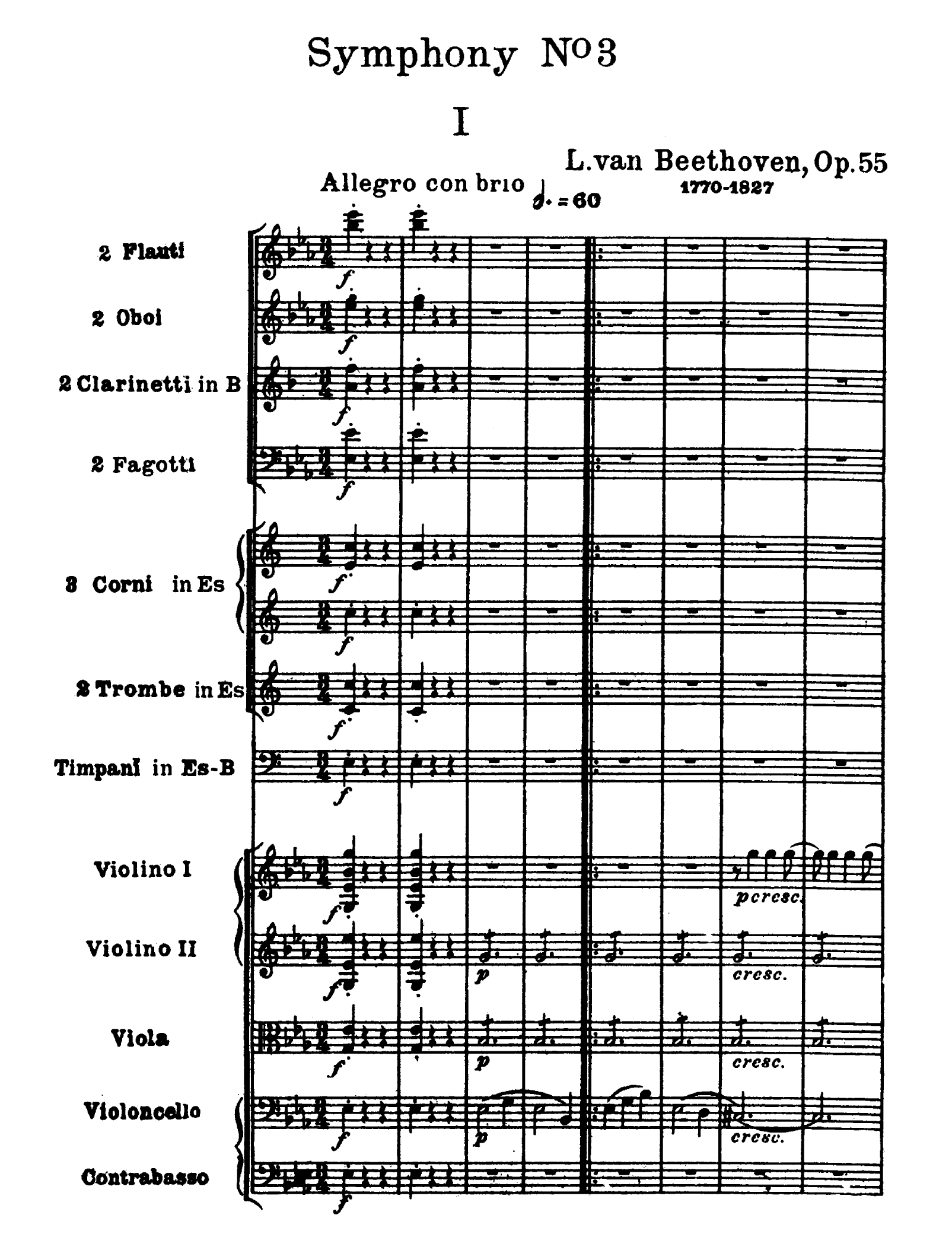









Chapter: PART 1 - 2. The Wood Wind
Citation: Fidler, 1921, p. 23
Summary of Figure: An example from the Intermezzo of Mendelssohn's "Midsummer Night's Dream" demonstrating string and woodwind writing in general. Editor: Fidler references the string parts of the whole movement as an example, without specifying the excerpt chosen here.
Exemplification of: woodwinds and strings, general writing style
Composer and Work: Mendelssohn, Felix. A Midsummer Night's Dream, op.21 & 61 (Ein Sommernachtstraum) <1827–1843> 5. Intermezzo, after Act II



Chapter: PART 1 - 2. The Wood Wind
Citation: Fidler, 1921, p. 23
Summary of Figure: Several discontinuous examples from the first movement of Tchaikovsky's Symphony No. 6 ("Pathétique") demonstrating bassoon writing in general. Editor: Fidler references the whole movement as an example, without specifying the excerpts chosen here.
Exemplification of: bassoon general writing style
Composer and Work: Tchaikovsky, Piotr Ilyich. Symphony No.6, op.74, TH 30, B minor (Pathétique; Pateticheskaia) <1893> I. Adagio - Allegro non troppo









Chapter: PART 1 - 2. The Wood Wind
Citation: Fidler, 1921, p. 24
Summary of Figure: An example from the Wedding March of Mendelssohn's "Midsummer Night's Dream" demonstrating string and woodwind writing in general. Editor: Fidler references the string parts of the whole movement as an example, without specifying the excerpt chosen here.
Exemplification of: woodwinds and strings, general writing style
Composer and Work: Mendelssohn, Felix. A Midsummer Night's Dream, op.21 & 61 (Ein Sommernachtstraum) <1827–1843> 9. Wedding March (after Act IV)




Chapter: PART 1 - 2. The Wood Wind
Citation: Fidler, 1921, p. 24
Summary of Figure: An example from the "Danse des mirlitons" of Tchaikovsky's "Nutcracker" demonstrating flute writing in general. This excerpt prominently features the use of three flutes for a soli melody. Editor: Fidler references the flute parts of the whole Suite, and of this complete movement in particular as examples, without specifying the excerpt chosen here.
Exemplification of: three flute soli melody, flute general writing style
Composer and Work: Tchaikovsky, Piotr Ilyich. Nutcracker (Shchelkunchik; Casse-noisette): Suite No.1, op.71A, TH 35 <1891–1892> (f) Danse des mirlitons



Chapter: PART 1 - 2. The Wood Wind
Citation: Fidler, 1921, p. 24
Summary of Figure: An example from the Scherzo of Mendelssohn's "Midsummer Night's Dream" demonstrating string and woodwind writing in general. Editor: Fidler references the string parts of the whole movement as an example, without specifying the excerpt chosen here.
Exemplification of: woodwinds and strings, general writing style
Composer and Work: Mendelssohn, Felix. A Midsummer Night's Dream, op.21 & 61 (Ein Sommernachtstraum) <1827–1843> 1. Scherzo (after Act I)


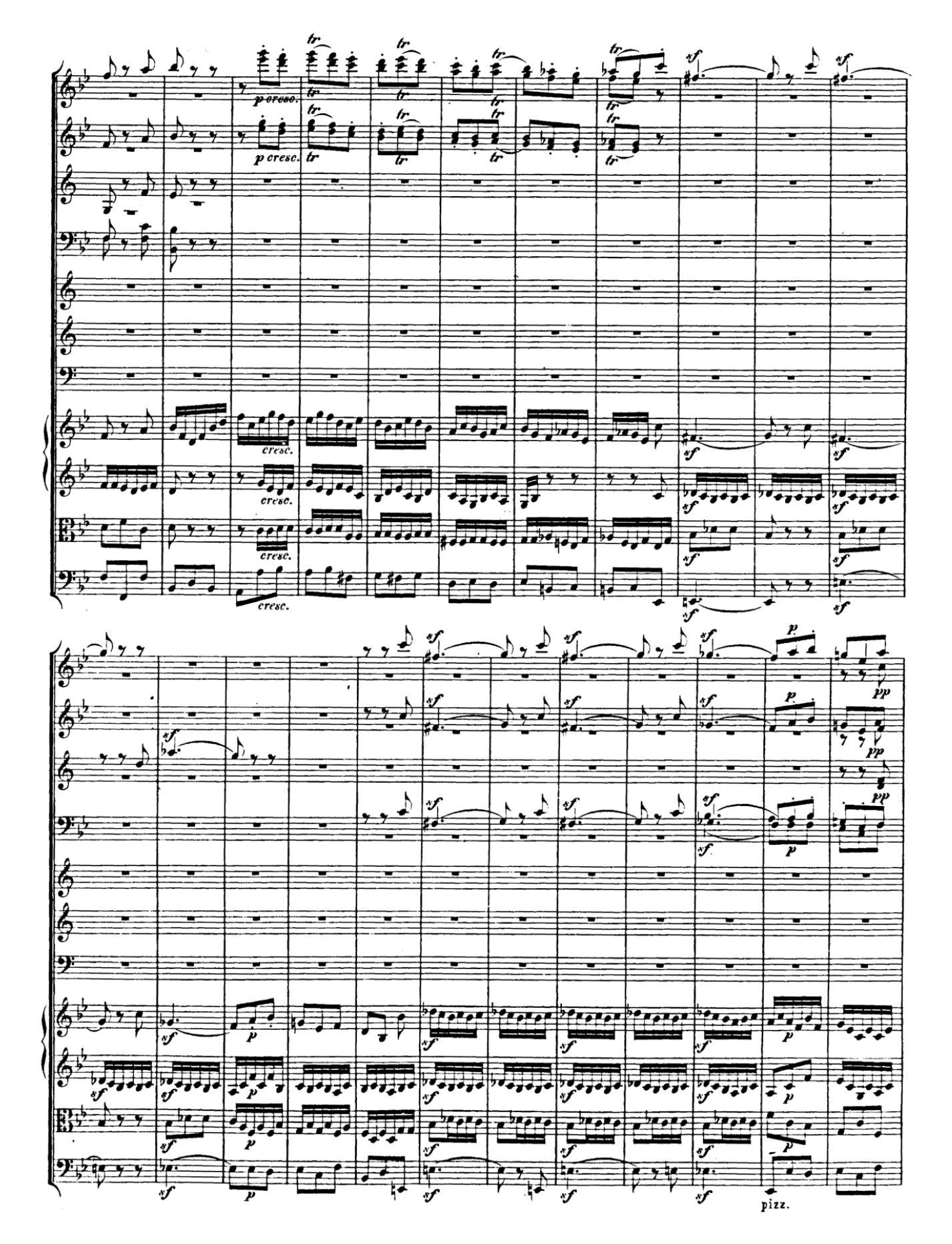
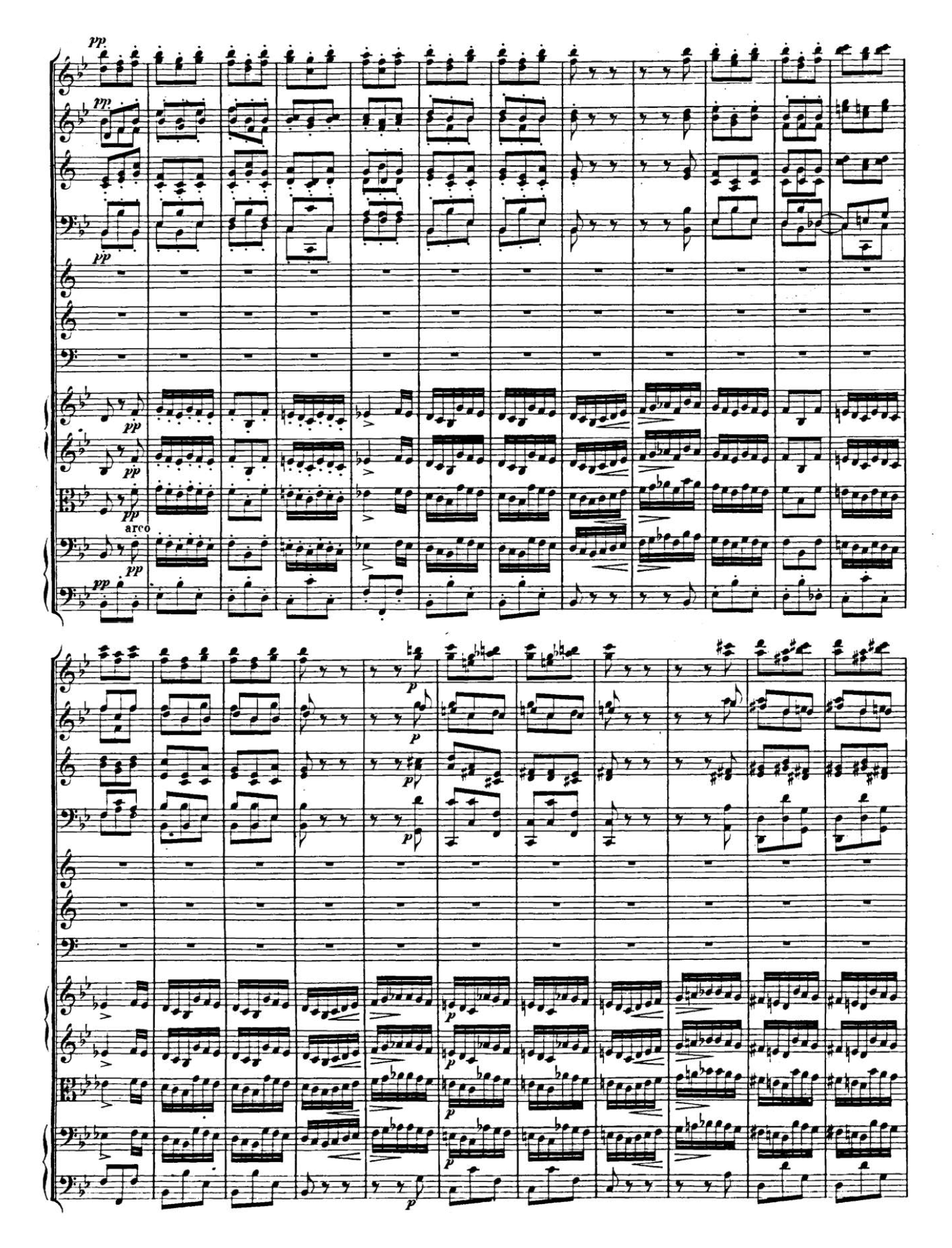
Chapter: PART 1 - 2. The Wood Wind
Citation: Fidler, 1921, p. 25
Summary of Figure: An example from the Scherzo of Beethoven's Symphony No. 3 ("Eroica") demonstrating the use of the second wind parts for reinforcement in tutti passages, doubling the same line as the first part either at the unison or octave.
Exemplification of: winds unison/octave doubling, reinforcement in tutti passages
Composer and Work: Beethoven, Ludwig van. Symphony No.3, op.55, E-flat major (Eroica) <1803> III. Scherzo: Allegro vivace
Fidler, 1921, p. 25 [Note: An example from the Scherzo of Beethoven's Symphony No. 3 ("Eroica") demonstrating the use of the second wind parts for reinforcement in tutti passages, doubling the same line as the first part either at the unison or octave.]
Chapter: PART 1 - 2. The Wood Wind
Citation: Fidler, 1921, p. 25
Summary of Figure: An example from the first movement of Beethoven's Symphony No. 3 ("Eroica") demonstrating the use of separate wind parts to produce full voicings of chords in a tutti passage.
Exemplification of: winds voicing, tutti chords
Composer and Work: Beethoven, Ludwig van. Symphony No.3, op.55, E-flat major (Eroica) <1803> I. Allegro con brio
Fidler, 1921, p. 25 [Note: An example from the first movement of Beethoven's Symphony No. 3 ("Eroica") demonstrating the use of separate wind parts to produce full voicings of chords in a tutti passage.]
Chapter: PART 1 - 2. The Wood Wind
Citation: Fidler, 1921, p. 26
Summary of Figure: An example from the first movement of Beethoven's Symphony No. 3 ("Eroica") demonstrating melodic doubling in thirds and sixths between the pairs of winds.
Exemplification of: winds thirds/sixths doubling
Composer and Work: Beethoven, Ludwig van. Symphony No.3, op.55, E-flat major (Eroica) <1803> I. Allegro con brio
![Fidler, 1921, p, 26 [Note: An example from the first movement of Beethoven's Symphony No. 3 ("Eroica") demonstrating melodic doubling in thirds and sixths between the pairs of winds.]](https://images.squarespace-cdn.com/content/v1/60808497d3ad1e29c346fe97/1651199220504-XCKF3G39LGRPG28Y9Q82/FIDLER-1921-26%2C1%281%29-score-winds-pairs-doubling-thirds-sixths-beethoven+%281%29.png)
![Fidler, 1921, p, 26 [Note: An example from the first movement of Beethoven's Symphony No. 3 ("Eroica") demonstrating melodic doubling in thirds and sixths between the pairs of winds.]](https://images.squarespace-cdn.com/content/v1/60808497d3ad1e29c346fe97/1651199221870-NPMJJ8PTHL9QR7PO27Y1/FIDLER-1921-26%2C1%282%29-score-winds-pairs-doubling-thirds-sixths-beethoven+%281%29.png)
Chapter: PART 1 - 2. The Wood Wind
Citation: Fidler, 1921, p. 26
Summary of Figure: An example from the first movement of Beethoven's Symphony No. 3 ("Eroica") demonstrating melodic doubling in thirds between the pairs of winds.
Exemplification of: winds thirds doubling
Composer and Work: Beethoven, Ludwig van. Symphony No.3, op.55, E-flat major (Eroica) <1803> I. Allegro con brio
Fidler, 1921, p. 26 [Note: An example from the first movement of Beethoven's Symphony No. 3 ("Eroica") demonstrating melodic doubling in thirds between the pairs of winds.]
Chapter: PART 1 - 2. The Wood Wind
Citation: Fidler, 1921, p. 26
Summary of Figure: An example from the last movement of Beethoven's Symphony No. 3 ("Eroica") demonstrating the possibility of assigning a melody to the "second" wind player of a pair in order to give the solo player a period of rest. In this example, the flute melody is largely assigned to flute 2, giving flute 1 a short break.
Exemplification of: winds distribution of parts, flute 2 melody
Composer and Work: Beethoven, Ludwig van. Symphony No.3, op.55, E-flat major (Eroica) <1803> IV. Finale: Allegro molto
Fidler, 1921, p. 26 [Note: An example from the last movement of Beethoven's Symphony No. 3 ("Eroica") demonstrating the possibility of assigning a melody to the "second" wind player of a pair in order to give the solo player a period of rest. In this example, the flute melody is largely assigned to flute 2, giving flute 1 a short break.]
Chapter: PART 1 - 2. The Wood Wind
Citation: Fidler, 1921, p. 26
Summary of Figure: An example from the 2nd movement of Beethoven's Symphony No. 3 ("Eroica") demonstrating the possibility of assigning a melody to the "second" wind player of a pair in order to give the solo player a period of rest. In this example, the clarinet 2 and bassoon 2 parts sometimes play even when there is nothing for the first clarinet or bassoon, giving those players a short break.
Exemplification of: winds distribution of parts, clarinet 2 and bassoon 2 melodies
Composer and Work: Beethoven, Ludwig van. Symphony No.3, op.55, E-flat major (Eroica) <1803> II. Marcia funebre: Adagio assai


Part 1 - 3.
Chapter: PART 1 - 3. The Small Orchestra
Citation: Fidler, 1921, p. 27
Summary of Figure: An example from the Nocturne of Mendelssohn's "Midsummer Night's Dream" demonstrating small orchestra writing in general. Editor: Fidler references the whole movement as an example, without specifying the excerpt chosen here.
Exemplification of: small orchestra general writing style
Composer and Work: Mendelssohn, Felix. A Midsummer Night's Dream, op.21 & 61 (Ein Sommernachtstraum) <1827–1843> 7. Nocturne (end of Act III)



Chapter: PART 1 - 3. The Small Orchestra
Citation: Fidler, 1921, p. 27
Summary of Figure: Several discontinuous examples from the "Marche" of Tchaikovsky's "Nutcracker" demonstrating string, woodwind, and horn writing in general. Editor: Fidler references the whole movement as an example, without specifying the excerpts chosen here.
Exemplification of: small orchestra general writing style
Composer and Work: Tchaikovsky, Piotr Ilyich. Nutcracker (Shchelkunchik; Casse-noisette): Suite No.1, op.71A, TH 35 <1891–1892> II. (a) Marche






Chapter: PART 1 - 3. The Small Orchestra
Citation: Fidler, 1921, p. 28
Summary of Figure: An example from the "Trepak" of Tchaikovsky's "Nutcracker" demonstrating string, woodwind, and horn writing in general. Editor: Fidler references the whole movement as an example, without specifying the excerpt chosen here.
Exemplification of: small orchestra general writing style
Composer and Work: Tchaikovsky, Piotr Ilyich. Nutcracker (Shchelkunchik; Casse-noisette): Suite No.1, op.71A, TH 35 <1891–1892> (c) Danse russe trepak





Chapter: PART 1 - 3. The Small Orchestra
Citation: Fidler, 1921, p. 28
Summary of Figure: An example from the "Danse arabe" of Tchaikovsky's "Nutcracker" demonstrating small orchestra writing in general. Editor: Fidler references the whole movement as an example, without specifying the excerpt chosen here.
Exemplification of: small orchestra general writing style
Composer and Work: Tchaikovsky, Piotr Ilyich. Nutcracker (Shchelkunchik; Casse-noisette): Suite No.1, op.71A, TH 35 <1891–1892> (d) Danse arabe
![Fidler, 1921, p. 28 [Note: An example from the "Danse arabe" of Tchaikovsky's "Nutcracker" demonstrating small orchestra writing in general. Editor: Fidler references the whole movement as an example, without specifying the excerpt chosen here.]](https://images.squarespace-cdn.com/content/v1/60808497d3ad1e29c346fe97/1651196574781-MI7O5939OOHGUP5KE5P6/FIDLER-1921-28%2C2%281%29-score-small-orchestra-general-writing-tchaikovsky.png)
![Fidler, 1921, p. 28 [Note: An example from the "Danse arabe" of Tchaikovsky's "Nutcracker" demonstrating small orchestra writing in general. Editor: Fidler references the whole movement as an example, without specifying the excerpt chosen here.]](https://images.squarespace-cdn.com/content/v1/60808497d3ad1e29c346fe97/1651196575152-SY4SZVW44AWA1MWMOTYG/FIDLER-1921-28%2C2%282%29-score-small-orchestra-general-writing-tchaikovsky.png)
![Fidler, 1921, p. 28 [Note: An example from the "Danse arabe" of Tchaikovsky's "Nutcracker" demonstrating small orchestra writing in general. Editor: Fidler references the whole movement as an example, without specifying the excerpt chosen here.]](https://images.squarespace-cdn.com/content/v1/60808497d3ad1e29c346fe97/1651196575905-YNAGC2RMMXCLMY94TLXB/FIDLER-1921-28%2C2%283%29-score-small-orchestra-general-writing-tchaikovsky.png)
![Fidler, 1921, p. 28 [Note: An example from the "Danse arabe" of Tchaikovsky's "Nutcracker" demonstrating small orchestra writing in general. Editor: Fidler references the whole movement as an example, without specifying the excerpt chosen here.]](https://images.squarespace-cdn.com/content/v1/60808497d3ad1e29c346fe97/1651196576201-XH0FUV7JMF83XC6JR2H9/FIDLER-1921-28%2C2%284%29-score-small-orchestra-general-writing-tchaikovsky.png)
Chapter: PART 1 - 3. The Small Orchestra
Citation: Fidler, 1921, p. 29
Summary of Figure: Several discontinuous examples from the third movement of Tchaikovsky's Symphony No. 6 ("Pathétique") demonstrating small orchestra writing in general. Editor: Fidler references the whole movement as an example, without specifying the excerpts chosen here.
Exemplification of: small orchestra general writing style
Composer and Work: Tchaikovsky, Piotr Ilyich. Symphony No.6, op.74, TH 30, B minor (Pathétique; Pateticheskaia) <1893> III. Allegro molto vivace







Chapter: PART 1 - 4. The Full Orchestra
Citation: Fidler, 1921, p. 31
Summary of Figure: An example from the "Danse des mirlitons" of Tchaikovsky's "Nutcracker" demonstrating full orchestral writing in general. Editor: Fidler references this whole movement as an example, without specifying the excerpt chosen here.
Exemplification of: full orchestra general writing style
Composer and Work: Tchaikovsky, Piotr Ilyich. Nutcracker (Shchelkunchik; Casse-noisette): Suite No.1, op.71A, TH 35 <1891–1892> (f) Danse des mirlitons


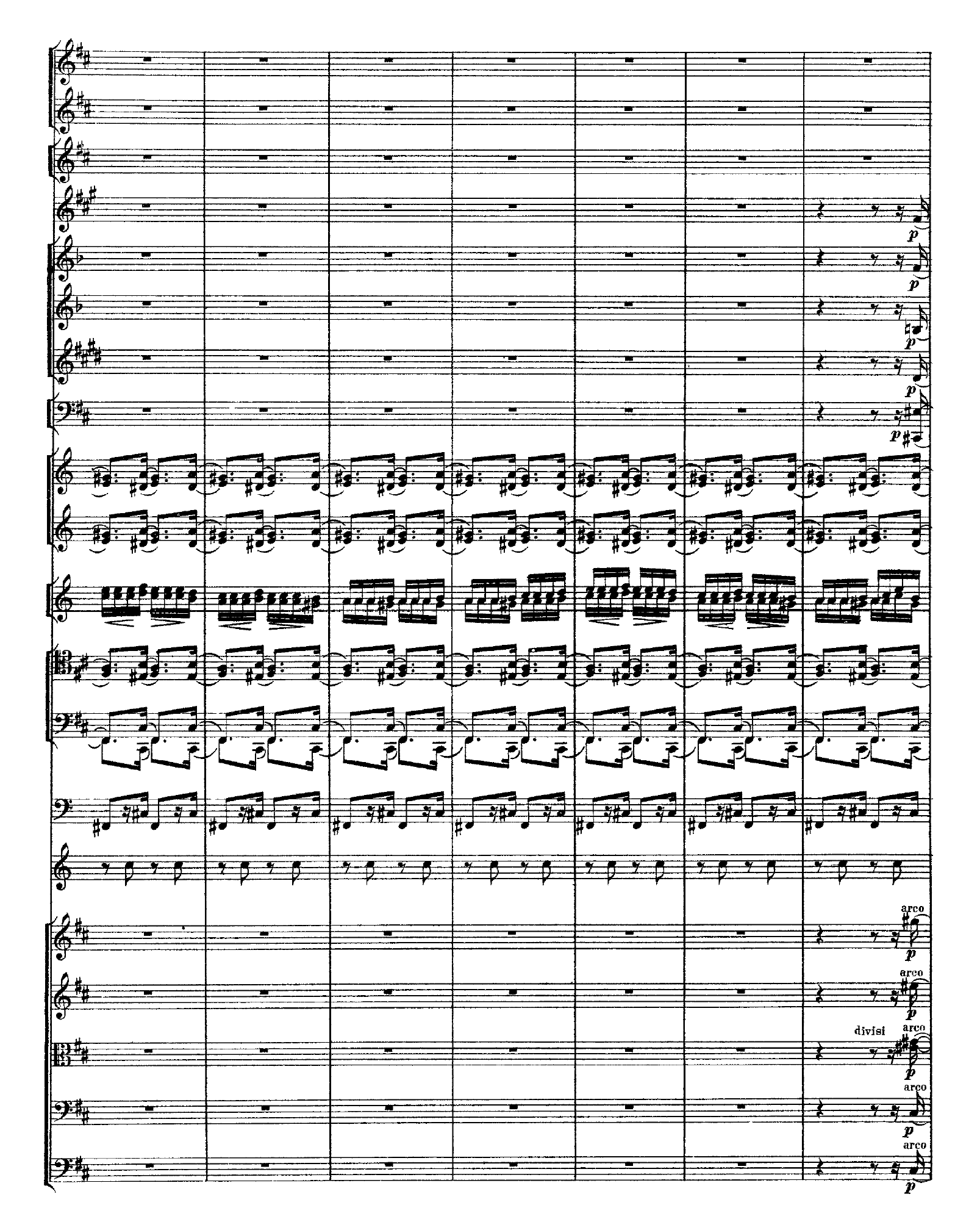


Chapter: PART 1 - 5. Notes for Advanced Students
Citation: Fidler, 1921, p. 43
Summary of Figure: An example from Tchaikovsky's Symphony No. 6 ("Pathétique") demonstrating doubling between winds and brass in such a way that the brass timbre predominates but is "mellowed" by the winds. In this example, the trumpet melody in octaves is doubled at the unison by oboes and bassoons respectively.
Exemplification of: wind-brass doubling, balance of sections, oboe-trumpet and bassoon-trumpet unison doubling, trumpets octave doubling
Composer and Work: Tchaikovsky, Piotr Ilyich. Symphony No.6, op.74, TH 30, B minor (Pathétique; Pateticheskaia) <1893> I. Adagio - Allegro non troppo
Fidler, 1921, p. 43 [Note: An example from Tchaikovsky's Symphony No. 6 ("Pathétique") demonstrating doubling between winds and brass in such a way that the brass timbre predominates but is "mellowed" by the winds. In this example, the trumpet melody in octaves is doubled at the unison by oboes and bassoons respectively.]
PART II - The Instruments
Chapter: PART 2 - 1. The String Group
Citation: Fidler, 1921, p. 51
Summary of Figure: Several discontinuous examples from the first movement of Tchaikovsky's Symphony No. 6 ("Pathétique") demonstrating situations where string bowings are marked explicitely in order to suggest a specific technique, or what Fidler calls "special effects." Editor: Fidler references the whole movement as an example, without specifying the excerpts chosen here.
Exemplification of: strings bowings, notation
Composer and Work: Tchaikovsky, Piotr Ilyich. Symphony No.6, op.74, TH 30, B minor (Pathétique; Pateticheskaia) <1893> I. Adagio - Allegro non troppo
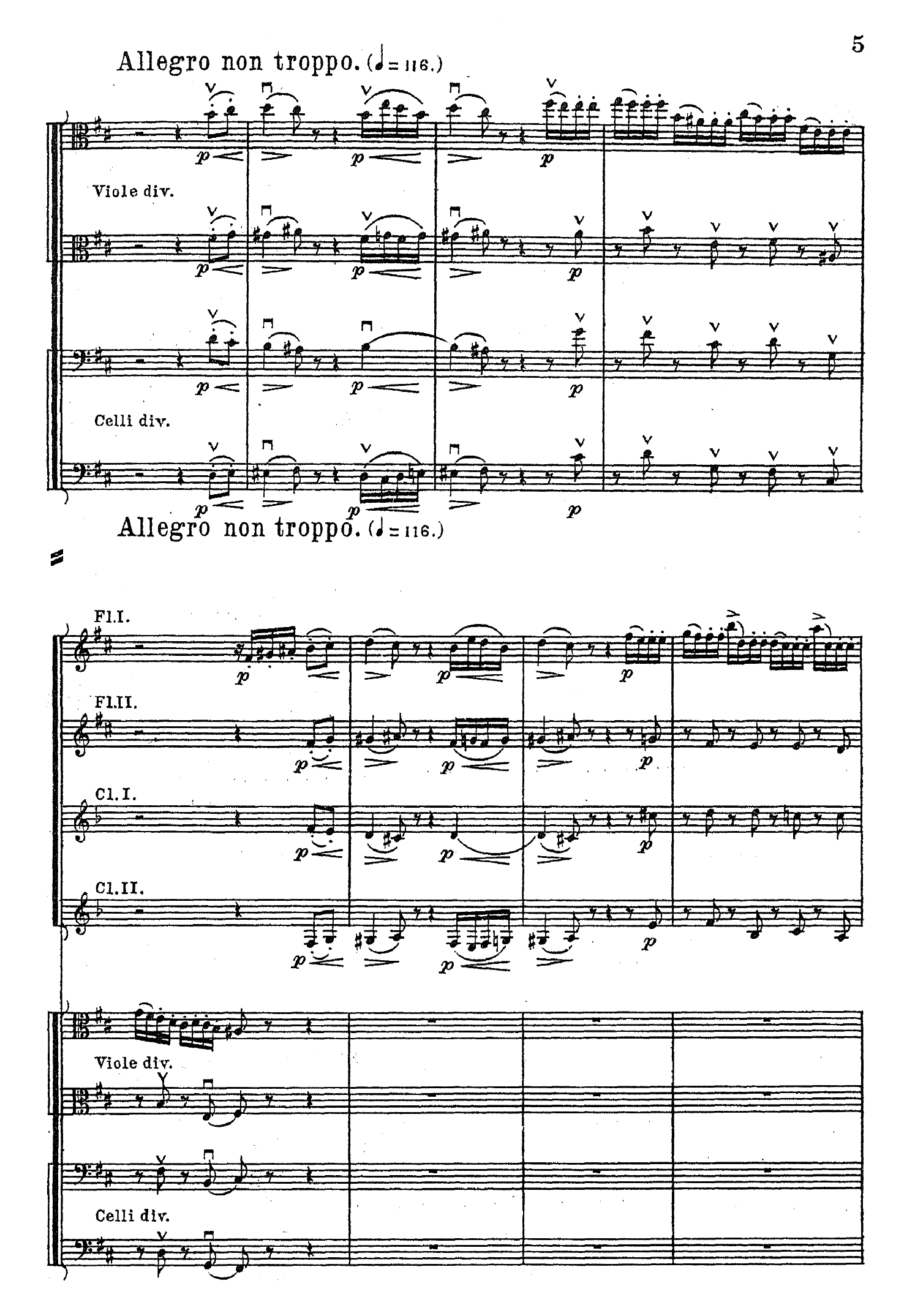

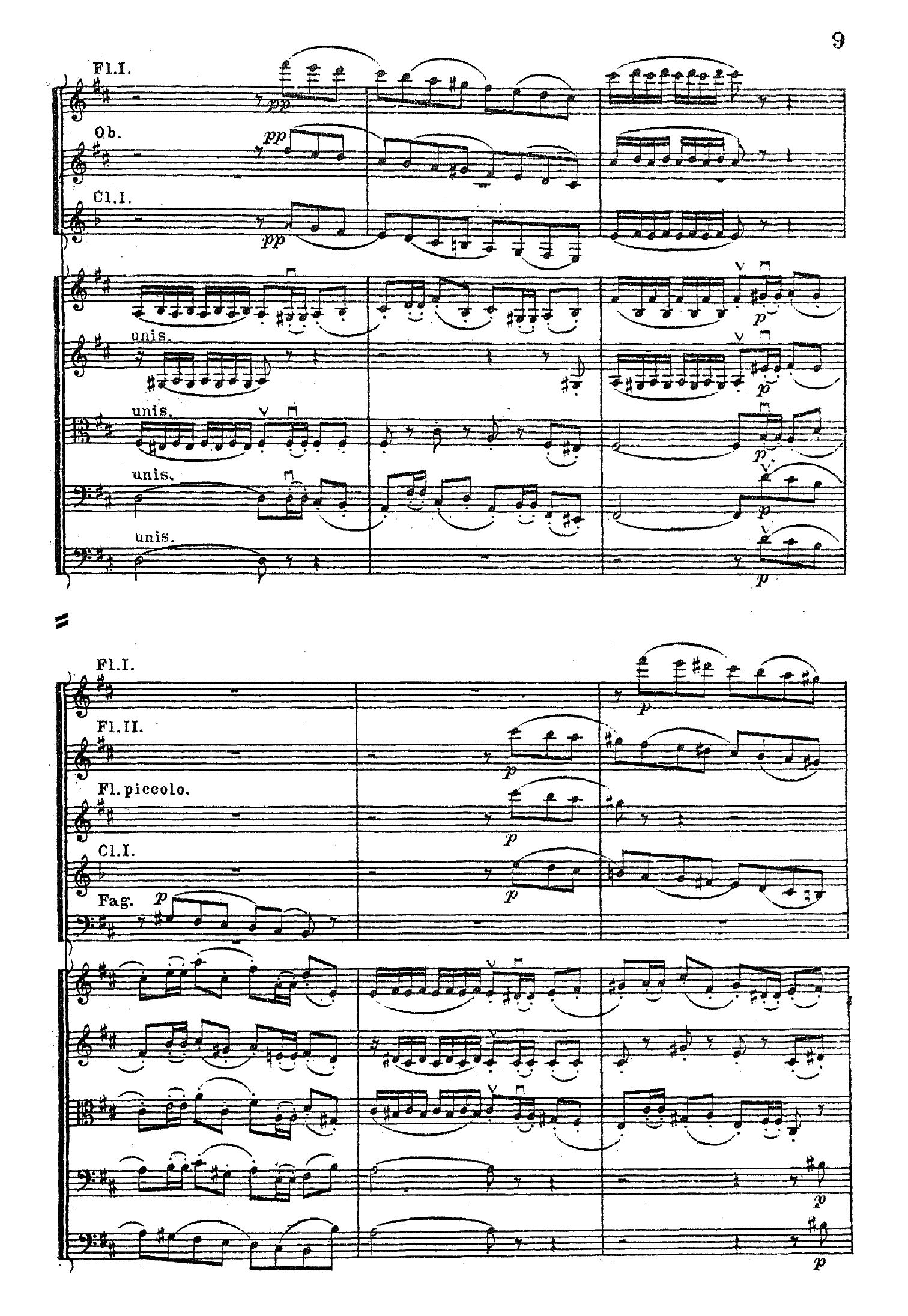
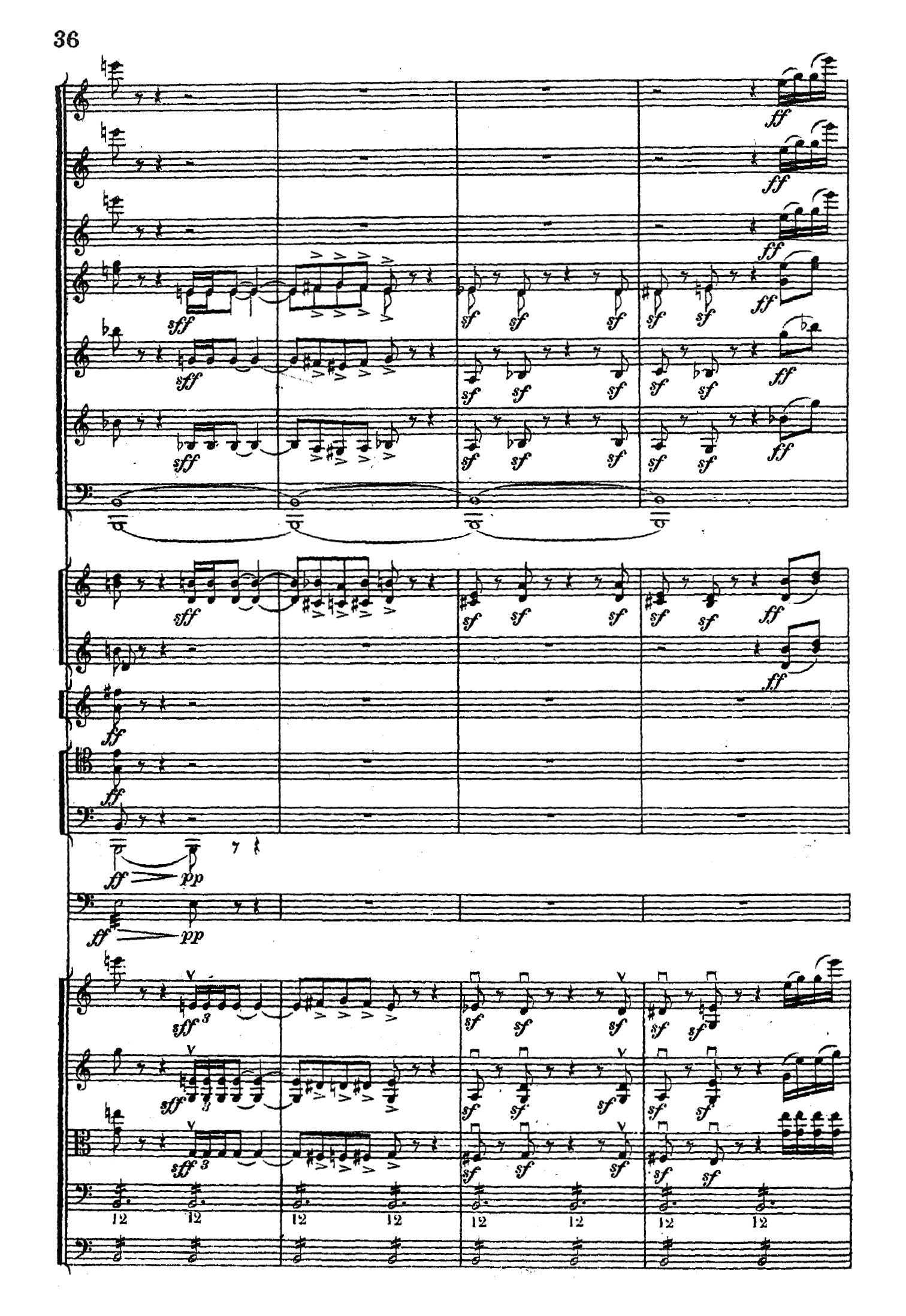
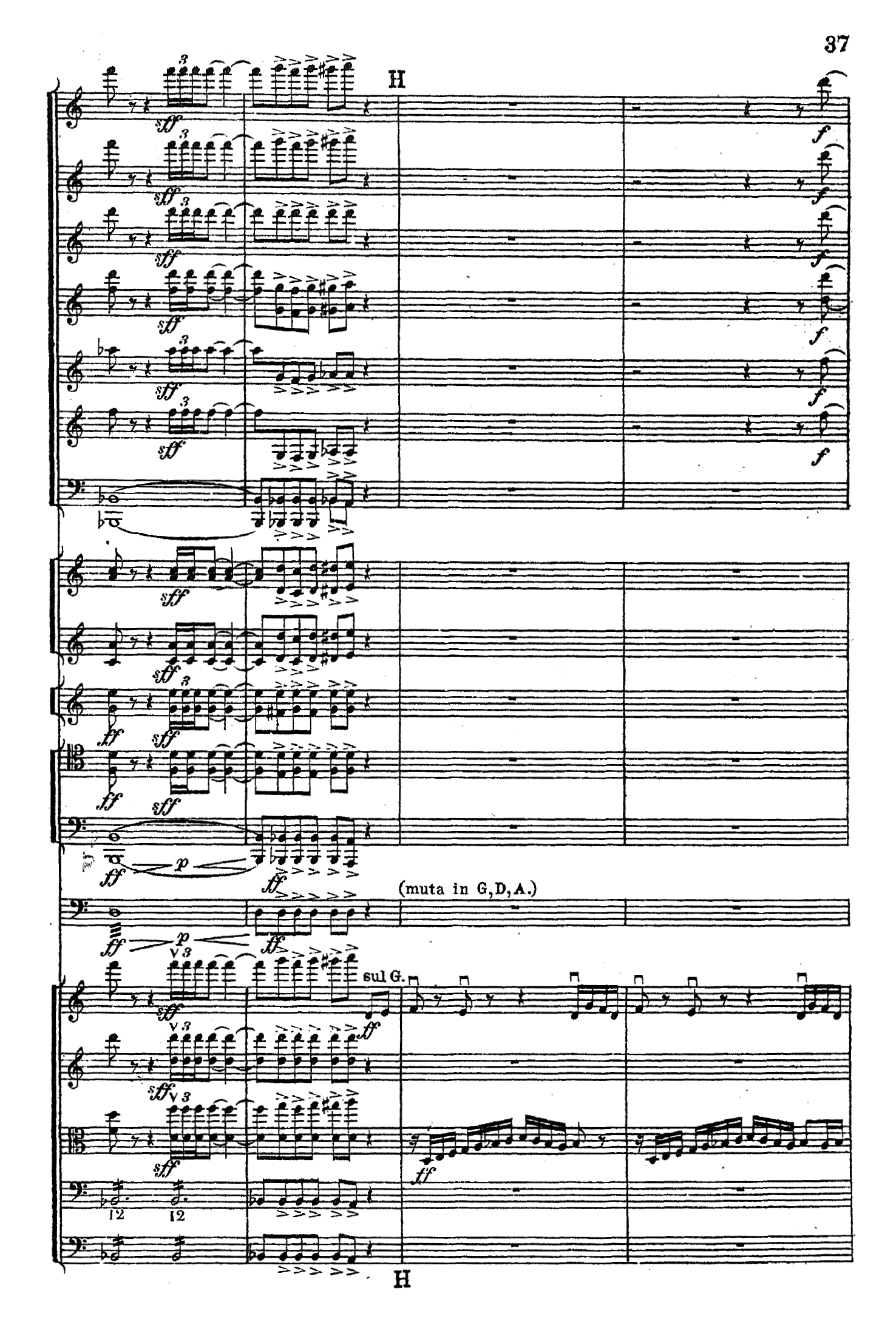
Chapter: PART 2 - 1. The String Group
Citation: Fidler, 1921, p. 52
Summary of Figure: A table showing the notes assigned to each finger on every string of the violin in positions 1 to 7. This table also applies to the viola if shifted down a fifth.
Exemplification of: violin and viola fingerings, positions
Fidler, 1921, p. 52 [Note: A table showing the notes assigned to each finger on every string of the violin in positions 1 to 7. This table also applies to the viola if shifted down a fifth.]
Chapter: PART 2 - 1. The String Group
Citation: Fidler, 1921, p. 56
Summary of Figure: A table showing the notation for the three kinds of tremolo possible on string instruments: bowed, fingered, and broken.
Exemplification of: strings tremolo, bowings, fingerings
Fidler, 1921, p. 56 [Note: A table showing the notation for the three kinds of tremolo possible on string instruments: bowed, fingered, and broken.]
Chapter: PART 2 - 2. The String Instruments
Citation: Fidler, 1921, p. 68
Summary of Figure: An example from Tchaikovsky's Symphony No. 6 ("Pathétique") demonstrating the division of the double bass section in order to facilitate the playing of a loud and fast passage.
Exemplification of: double bass divisi, double bass rapid and loud figures
Composer and Work: Tchaikovsky, Piotr Ilyich. Symphony No.6, op.74, TH 30, B minor (Pathétique; Pateticheskaia) <1893> I. Adagio - Allegro non troppo
![Fidler, 1921, p. 68 [Note: An example from Tchaikovsky's Symphony No. 6 ("Pathétique") demonstrating the division of the double bass section in order to facilitate the playing of a loud and fast passage.]](https://images.squarespace-cdn.com/content/v1/60808497d3ad1e29c346fe97/1651198808331-ULMSXON6S6KTR9IV0SGX/FIDLER-1921-68%281%29-instruments-doublebass-divisi-loud-fast-tchaikovsky+%281%29.png)
![Fidler, 1921, p. 68 [Note: An example from Tchaikovsky's Symphony No. 6 ("Pathétique") demonstrating the division of the double bass section in order to facilitate the playing of a loud and fast passage.]](https://images.squarespace-cdn.com/content/v1/60808497d3ad1e29c346fe97/1651198806395-FIXTABGO67FP50LCV8T9/FIDLER-1921-68%282%29-instruments-doublebass-divisi-loud-fast-tchaikovsky+%281%29.png)
Chapter: PART 2 - 4. The Wind Instruments
Citation: Fidler, 1921, p. 87
Summary of Figure: An example from the opening of Tchaikovsky's Symphony No. 6 ("Pathétique") demonstrating a low solo bassoon line which, according to Fidler, is often doubled at the unison in performance by a pianissimo bass clarinet.
Exemplification of: bassoon-bass clarinet unison doubling, bass clarinet dynamics, pianissimo
Composer and Work: Tchaikovsky, Piotr Ilyich. Symphony No.6, op.74, TH 30, B minor (Pathétique; Pateticheskaia) <1893> I. Adagio - Allegro non troppo
Chapter: PART 2 - 4. The Wind Instruments
Citation: Fidler, 1921, p. 93
Summary of Figure: An example from the Scherzo of Beethoven's Symphony No. 3 ("Eroica") demonstrating the use of the high register (above the stave) of the horn. This excerpt exemplifies Fidler's recommendation to write mostly by step in this register of the horn.
Exemplification of: horn high register, stepwise voice-leading
Composer and Work: Beethoven, Ludwig van. Symphony No.3, op.55, E-flat major (Eroica) <1803> III. Scherzo: Allegro vivace
Fidler, 1921, p. 93 [Note: An example from the Scherzo of Beethoven's Symphony No. 3 ("Eroica") demonstrating the use of the high register (above the stave) of the horn. This excerpt exemplifies Fidler's recommendation to write mostly by step in this register of the horn.]
Chapter: PART 2 - 4. The Wind Instruments
Citation: Fidler, 1921, p. 93
Summary of Figure: An example from the Nocturne of Mendelssohn's "Midsummer Night's Dream" demonstrating the capacity for a horn melody to stand out, even when accompanied by the tutti. Editor: Fidler does not specify the relevant page or bar numbers within the movement, but is likely referring to this passage.
Exemplification of: horn melody, prominence of horn section in tutti
Composer and Work: Mendelssohn, Felix. A Midsummer Night's Dream, op.21 & 61 (Ein Sommernachtstraum) <1827–1843> 7. Nocturne (end of Act III)



Chapter: PART 2 - 4. The Wind Instruments
Citation: Fidler, 1921, p. 98
Summary of Figure: A table showing the pitches available with each slide position on the tenor trombone. This table also applies to the bass trombone if shifted down a minor third.
Exemplification of: trombone slide positions
Fidler, 1921, p. 98 [Note: A table showing the pitches available with each slide position on the tenor trombone. This table also applies to the bass trombone if shifted down a minor third.]
Chapter: PART 2 - 4. The Wind Instruments
Citation: Fidler, 1921, p. 103
Summary of Figure: An example showing two slightly different ways of notating rolls for percussion instruments. They differentiate between the roll simply stopping at the end of the last note value or the last individual written note being articulated as a single stroke.
Exemplification of: percussion rolls, notation
Fidler, 1921, p. 103 [Note: An example showing two slightly different ways of notating rolls for percussion instruments. They differentiate between the roll simply stopping at the end of the last note value or the last individual written note being articulated as a single stroke.]
Chapter: PART 2 - 5. The Percussion Group
Citation: Fidler, 1921, p. 108
Summary of Figure: A table showing the notation for four common types of strokes on the snare drum: the roll, paradiddle, drag, and flam.
Exemplification of: snare drum strokes
Fidler, 1921, p. 108 [Note: A table showing the notation for four common types of strokes on the snare drum: the roll, paradiddle, drag, and flam.]
Chapter: PART 2 - 6. The Percussion Instruments and the Harp
Citation: Fidler, 1921, p. 113
Summary of Figure: An example from the "Dance of the Sugar Plum Fairy" from Tchaikovsky's "Nutcracker" demonstrating a characteristic celesta part, notated at sounding pitch rather than an octave below as is now conventional. This example also demonstrates a relationship of selective doubling, or "highlighting," between the solo celesta and the string and wind sections.
Exemplification of: celesta-winds and celesta-strings selective doubling, celesta transposing notation
Composer and Work: Tchaikovsky, Piotr Ilyich. Nutcracker (Shchelkunchik; Casse-noisette): Suite No.1, op.71A, TH 35 <1891–1892> (b) Danse de la fée-dragée (Dance of the Sugar Plum Fairy)
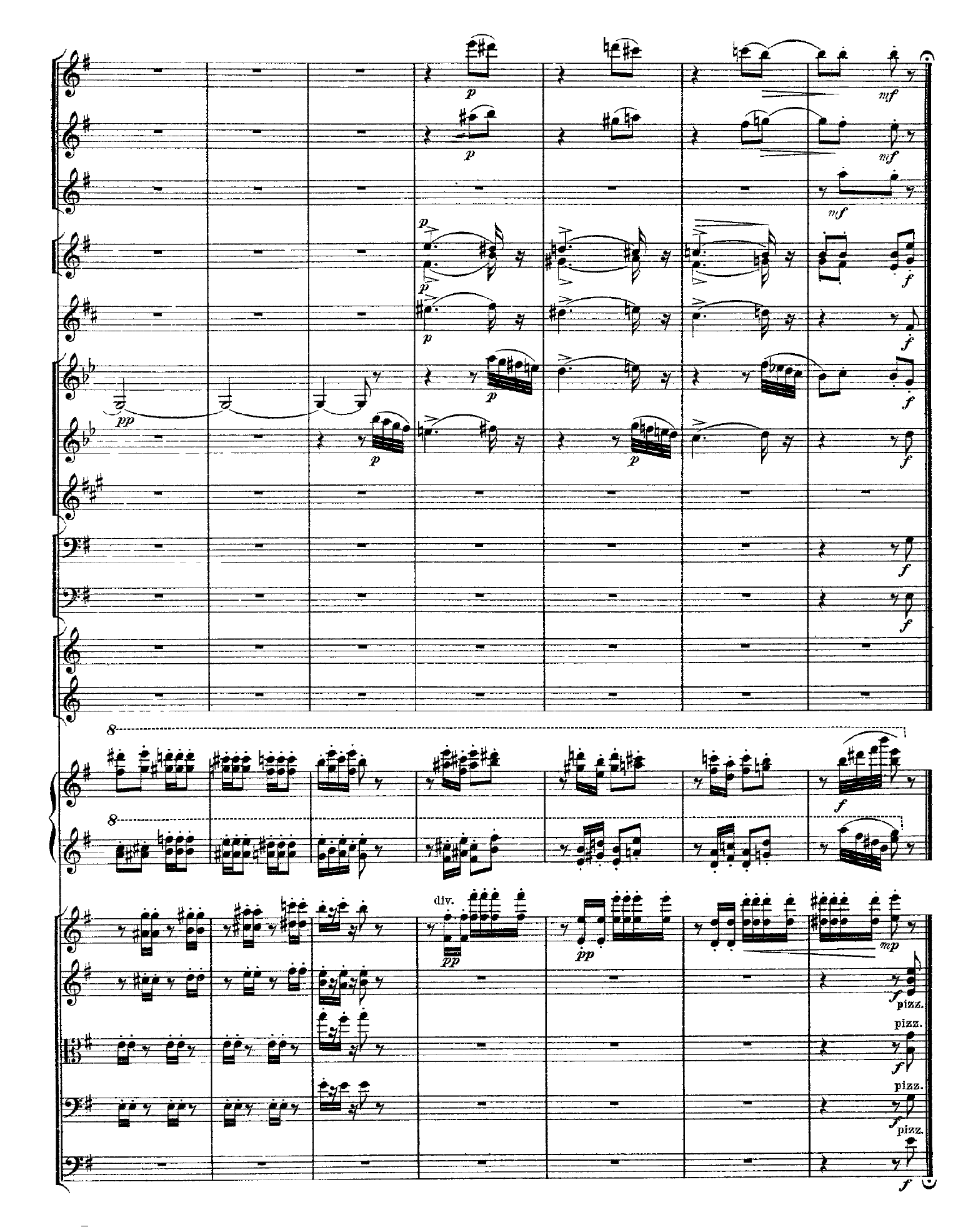

Chapter: On the Study of Old and Foreign Scores
Citation: Fidler, 1921, p. 126
Summary of Figure: An example from the first movement of Beethoven's Symphony No. 3 ("Eroica") showing the choice of horns crooked in E-flat, and notated in transposing pitch, i.e. a major sixth above sounding pitch.
Exemplification of: horn crook choice, transposing notation
Composer and Work: Beethoven, Ludwig van. Symphony No.3, op.55, E-flat major (Eroica) <1803> I. Allegro con brio
Chapter: On the Study of Old and Foreign Scores
Citation: Fidler, 1921, p. 126
Summary of Figure: An example from the C-minor 2nd movement of Beethoven's Symphony No. 3 ("Eroica") showing the choice of horns crooked in C and E-flat, and notated in transposing pitch, i.e. an octave (C) or major sixth (Eb) above sounding pitch.
Exemplification of: horn crook choice, transposing notation
Composer and Work: Beethoven, Ludwig van. Symphony No.3, op.55, E-flat major (Eroica) <1803> II. Marcia funebre: Adagio assai
Chapter: On the Study of Old and Foreign Scores
Citation: Fidler, 1921, p. 126
Summary of Figure: An example from the Scherzo of Mendelssohn's "Midsummer Night's Dream" showing the choice of horns crooked in D and notated in transposed pitch, i.e. a minor seventh above sounding pitch.
Exemplification of: horn crook choice, transposing notation
Composer and Work: Mendelssohn, Felix. A Midsummer Night's Dream, op.21 & 61 (Ein Sommernachtstraum) <1827–1843> 1. Scherzo (after Act I)
Chapter: On the Study of Old and Foreign Scores
Citation: Fidler, 1921, p. 127
Summary of Figure: An example from the Intermezzo of Mendelssohn's "Midsummer Night's Dream" showing the choice of horns crooked in A and notated in transposed pitch. Fidler points out the use of an archaic convention by which the horn parts are written an additional octave lower when in the bass clef, making the notated pitch a major sixth below sounding. When notated in treble clef, the notated pitch is a minor third above sounding, as is now conventional in either clef.
Exemplification of: horn crook choice, transposing notation, clefs
Composer and Work: Mendelssohn, Felix. A Midsummer Night's Dream, op.21 & 61 (Ein Sommernachtstraum) <1827–1843> 5. Intermezzo, after Act II
Chapter: On the Study of Old and Foreign Scores
Citation: Fidler, 1921, p. 127
Summary of Figure: An example from the first movement of Beethoven's Symphony No. 3 ("Eroica") showing the choice of trumpets crooked in E-flat, and notated in transposing pitch, i.e. a minor third below sounding pitch.
Exemplification of: trumpet crook choice, transposing notation
Composer and Work: Beethoven, Ludwig van. Symphony No.3, op.55, E-flat major (Eroica) <1803> I. Allegro con brio
Chapter: On the Study of Old and Foreign Scores
Citation: Fidler, 1921, p. 127
Summary of Figure: An example from the Scherzo of Mendelssohn's "Midsummer Night's Dream" showing the choice of trumpets crooked in D and notated in transposed pitch, i.e. a major second below sounding pitch.
Exemplification of: trumpet crook choice, transposing notation
Composer and Work: Mendelssohn, Felix. A Midsummer Night's Dream, op.21 & 61 (Ein Sommernachtstraum) <1827–1843> 1. Scherzo (after Act I)
![Fidler, 1921, p. 127 [Note: An example from the Scherzo of Mendelssohn's "Midsummer Night's Dream" showing the choice of trumpets crooked in D and notated in transposed pitch, i.e. a major second below sounding pitch.]](https://images.squarespace-cdn.com/content/v1/60808497d3ad1e29c346fe97/1651202599994-VR478IXAOY5N7W1PXAHK/FIDLER-1921-127%2C3%281%29-scores-trumpets-d-transposing-mendelssohn.png)
![Fidler, 1921, p. 127 [Note: An example from the Scherzo of Mendelssohn's "Midsummer Night's Dream" showing the choice of trumpets crooked in D and notated in transposed pitch, i.e. a major second below sounding pitch.]](https://images.squarespace-cdn.com/content/v1/60808497d3ad1e29c346fe97/1651202600337-WUI5IVS5858EIYSIZ1P5/FIDLER-1921-127%2C3%282%29-scores-trumpets-d-transposing-mendelssohn.png)
Chapter: Table of Instruments
Citation: Fidler, 1921, p. 129
Summary of Figure: A table showing the names of the common orchestral instruments in Italian, German, French, and English.
Exemplification of: instrument names, languages
Fidler, 1921, p. 129 [Note: A table showing the names of the common orchestral instruments in Italian, German, French, and English.]
On this page:















![Fidler, 1921, p. 129 [Note: A table showing the names of the common orchestral instruments in Italian, German, French, and English.]](https://images.squarespace-cdn.com/content/v1/60808497d3ad1e29c346fe97/1623888660563-PXY0FT48CI4CW3FYWEG5/FIDLER-1921-129-instrument-names-italian-german-french-english.png)